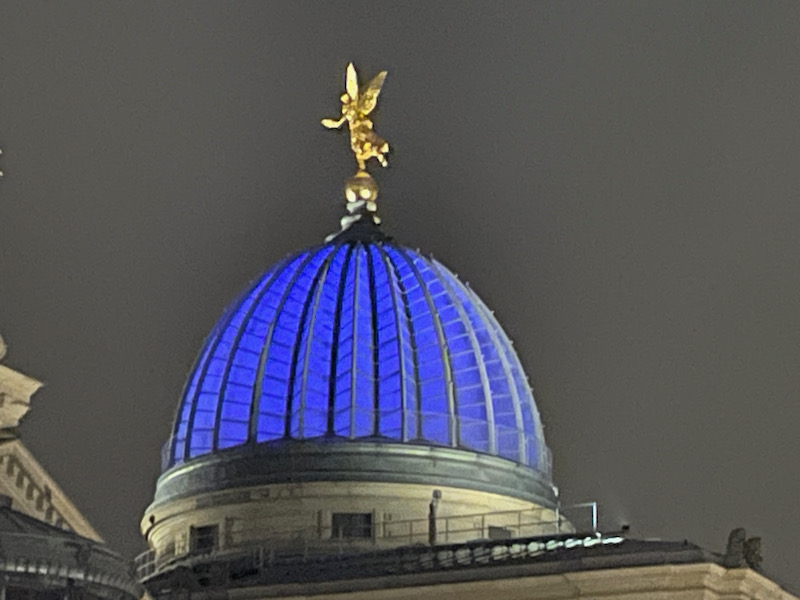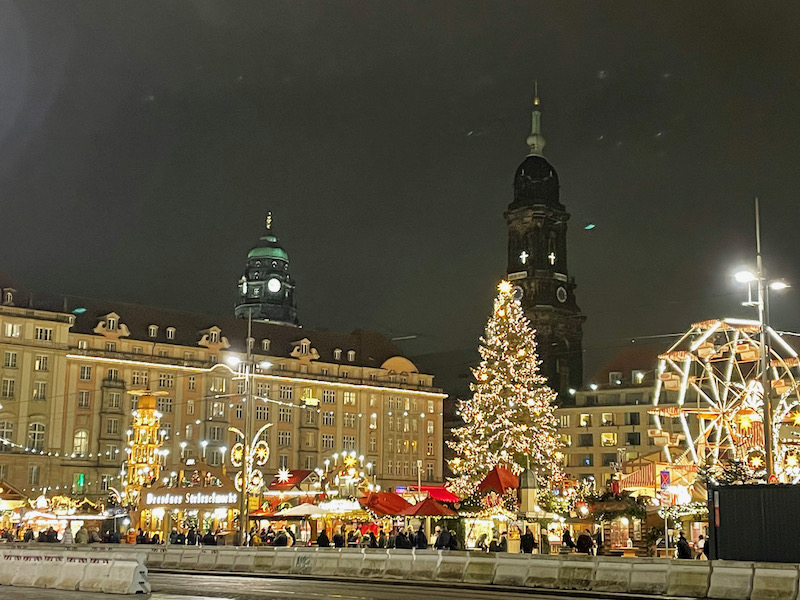Our Blog - Day 2 - Dresden, Germany
You'll see quite a few pictures here and there of Christmas Markets, since that was the reason for the trip to Dresden. The main market is called the Striezelmarkt. It was first mentioned in 1434 under Friedrich II, Elector of Saxony. At that time, it was a 1-day market held the Monday before Christmas, but it was in the same square as it is held today, in the Altmarkt (old market square). Interestingly enough, it started as a one-day market to provide the citizens of Dresden with the sale of meat for the Christmas meal after the traditional Advent period of fasting. It now has almost 250 stands and is open for the "Advent" period from roughly the 1st of December up to Christmas Eve. The name "Striezel" comes from "Strüzel", which now is called "Stollen", which is a Christmas cake.
One of the first things that you notice that is different here than other Christmas markets are the stands. In most markets, all of the stands look the same (like at our local Christmas market that has white stands). Here, the stands are all individually decorated, sometimes indicating what is sold there and other times just something funny. I grabbed a couple that I thought where interesting.
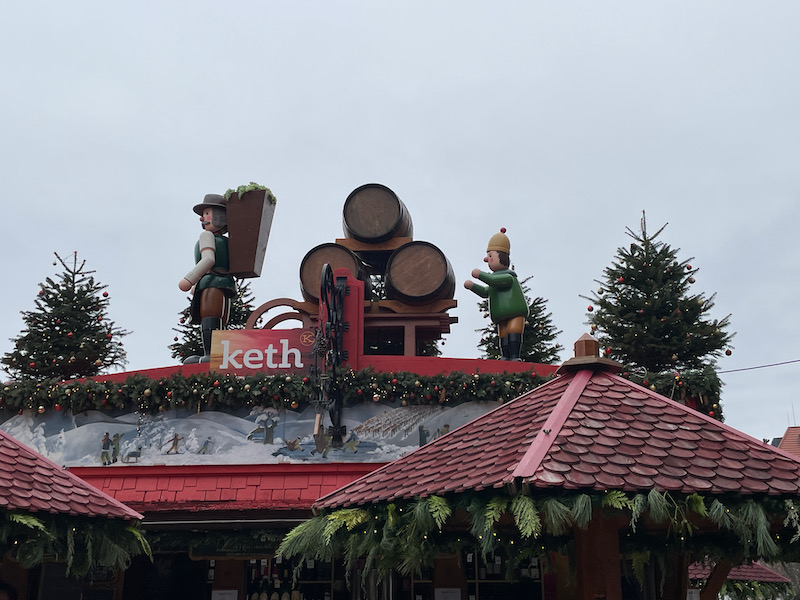
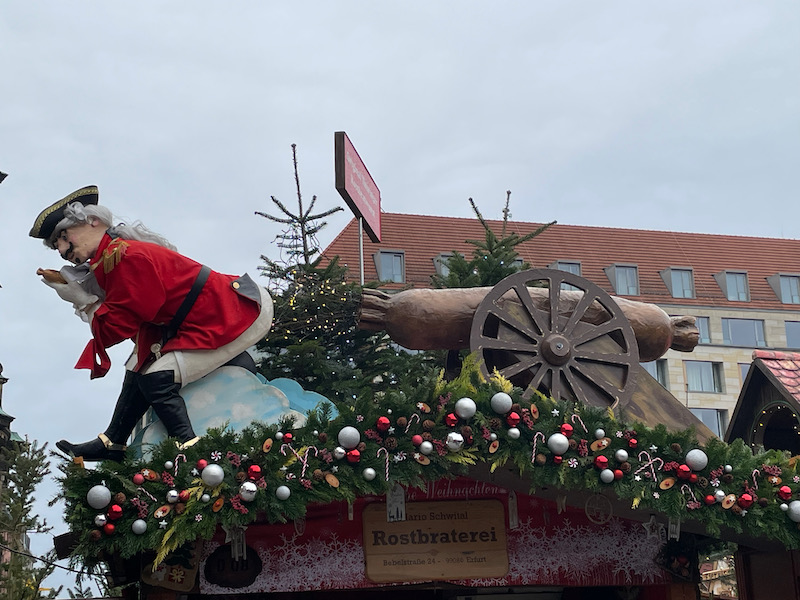
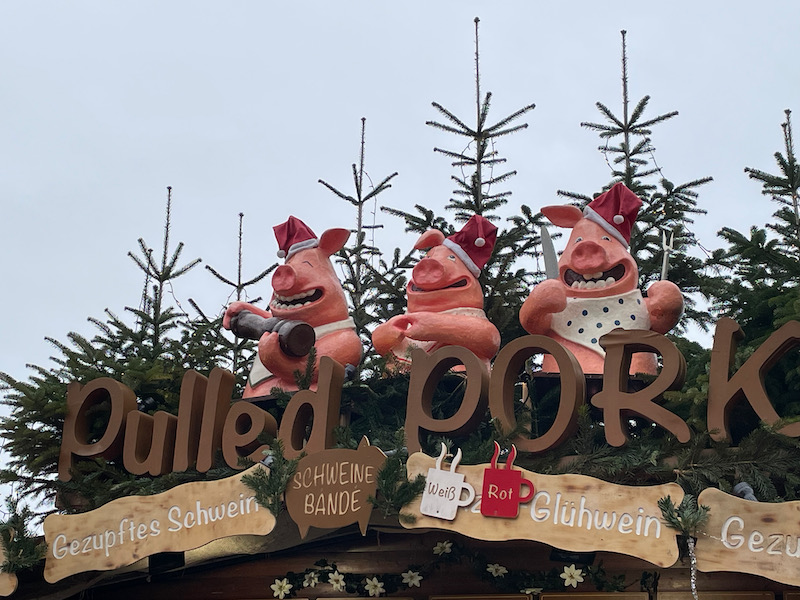
Another thing that is interesting here is the 46-foot-tall Christmas Pyramid, which supposedly is the tallest Christmas Pyramid in the world. In many parts of Germany, the candle pyramid is brought out every year to light up the room at Christmas. There are normally several tiers with round wooden circles that get smaller as it goes up. At the edges of the tiers are candles that, when lit, heat the air which then turns the rotor at the top which turns the tiers.
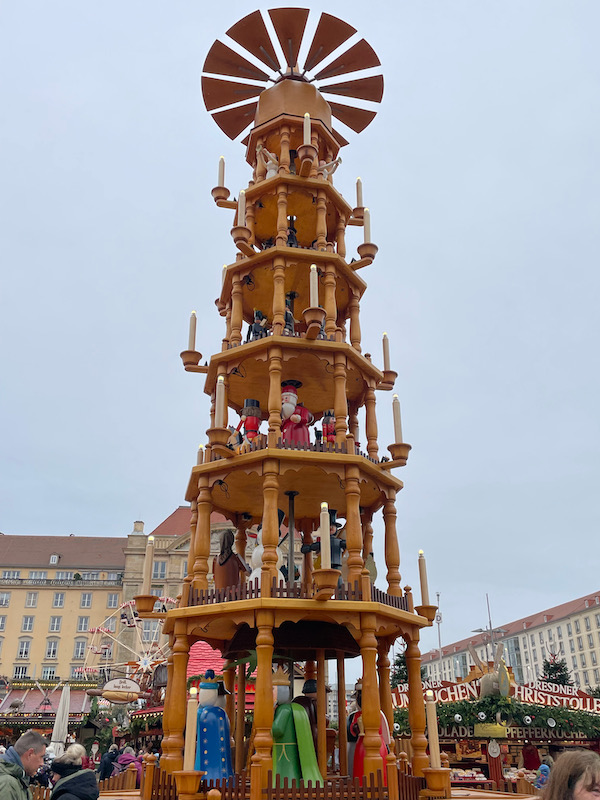
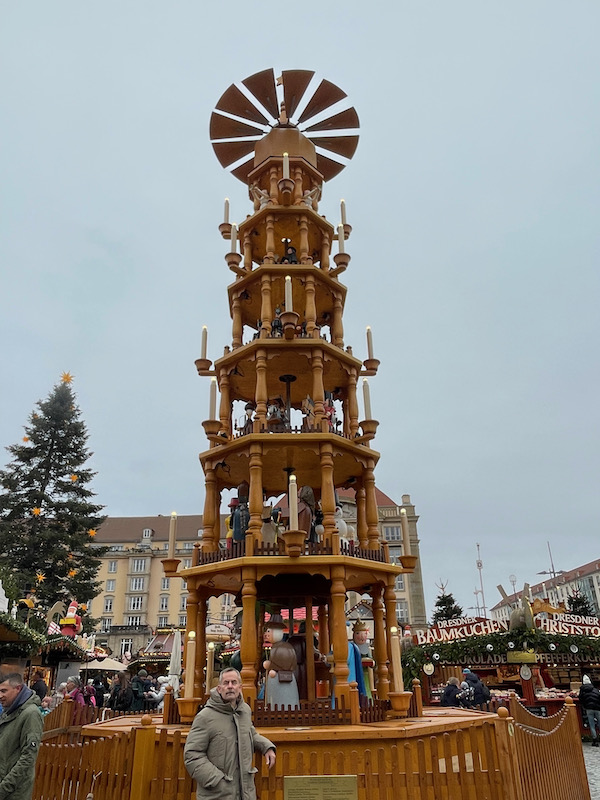
Then in the Neumarkt (new market square) was another small market and a smaller Christmas Pyramid. They also had a couple dancing bears that I decided to get a picture with. From here, we started a guided walking tour around the old historical center. I've mixed together pictures taken during the 2-hour tour with others from later in the day because we didn't go into any of the buildings during the tour and I wanted to keep the inside and outside pictures together.
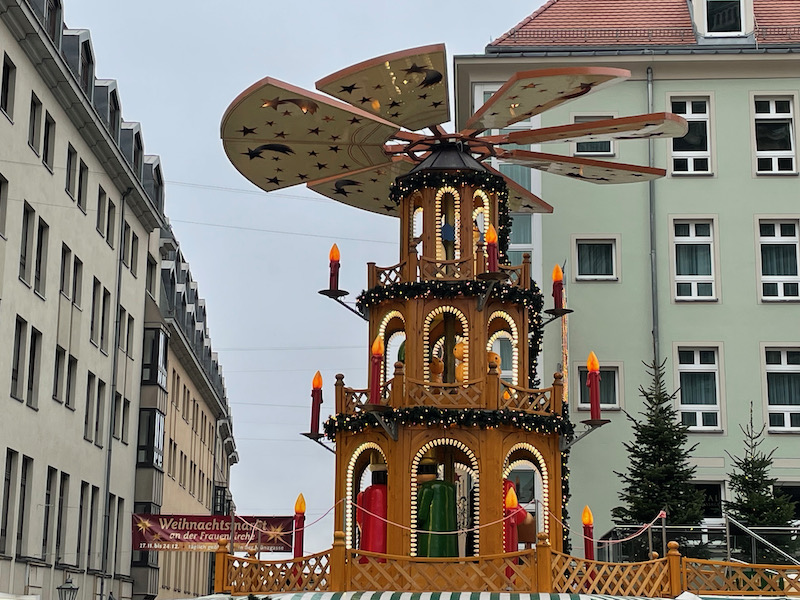
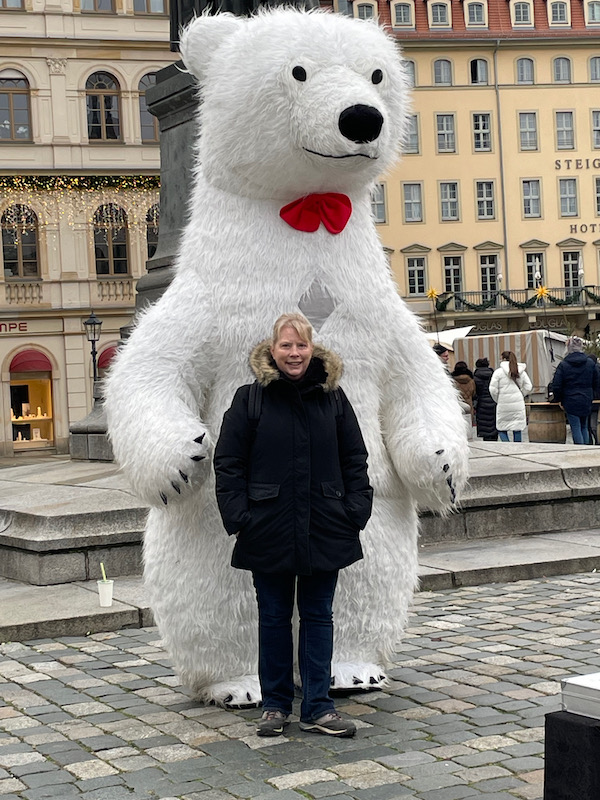
I'll start with the Fürstenzug, or Procession of Princes, which is a large mural on the side of the Stables Courtyard of the Dresden Castle. It was originally painted between 1871 and 1876 to celebrate the 800th anniversary of the Wettin Dynasty, Saxony's ruling family. They soon realized that the painting was not waterproof and was getting damaged by the weather. So between 1904 and 1907, they replaced the painting with approximately 23,000 painted porcelain tiles created in the nearby town of Meissen (which is famous for its porcelain factory). With a length of 335 ft, it is the largest porcelain artwork in the world. The mural displays the ancestral portraits of the 35 margraves, electors, dukes, and kings of the House of Wettin between 1127 and 1904. This is one of the FEW things in Dresden that was NOT heavily damaged in 1945! It starts with musicians and then we can see (2nd picture) Conrad I, called Conrad the Great (you can see the German below him, Konrad der Große). Then is Otto II "the Rich" and his son, Albert I "the Proud". I skipped a bunch of people, down to Augustus II "the Strong" and his son, Augustus III. The procession ends with a set of politicians, scientists, artisans, craftsmen, children and farmers, as the country transitioned from a monarchy to the Free State of Saxony in 1920 after the abdication of the last king, Frederick Augustus II of Saxony (who interestingly enough, is not shown in the procession).
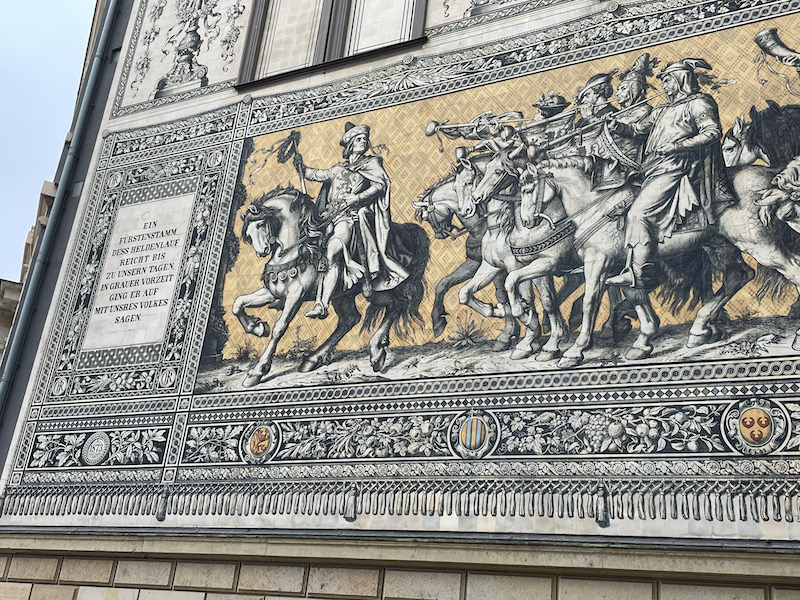
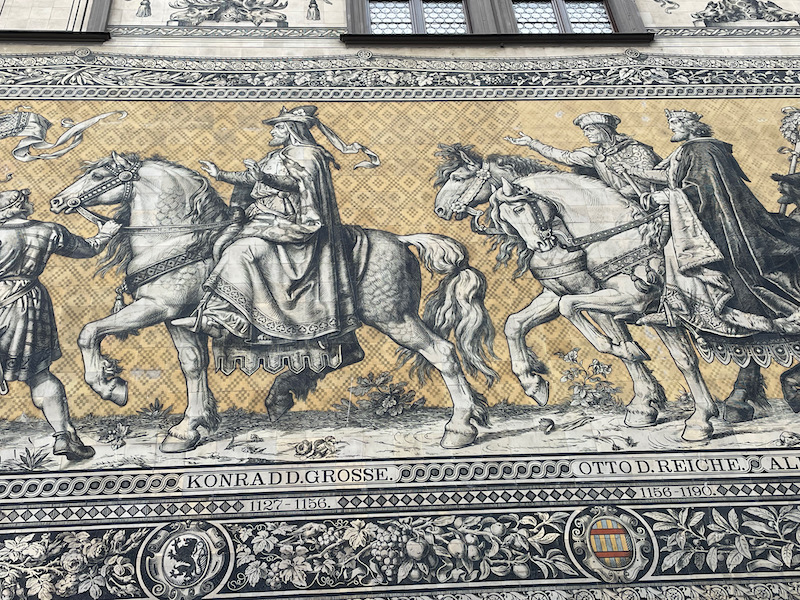
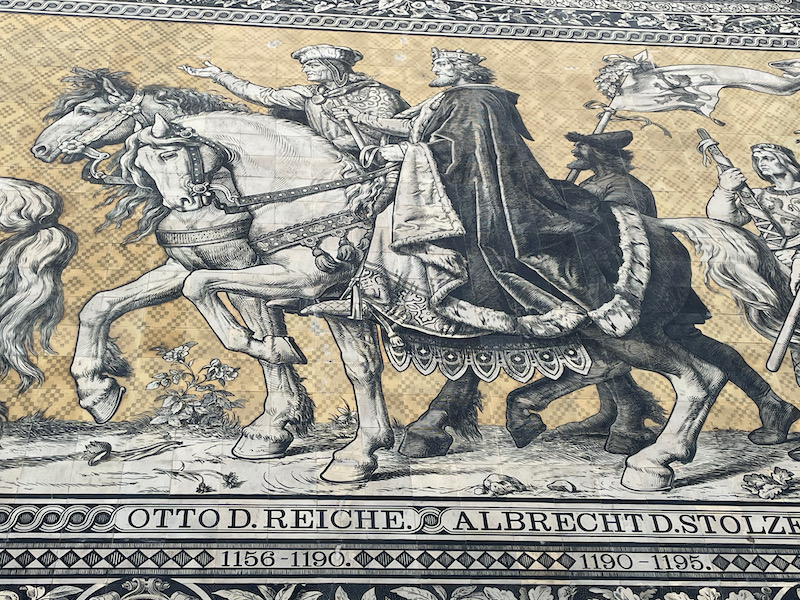
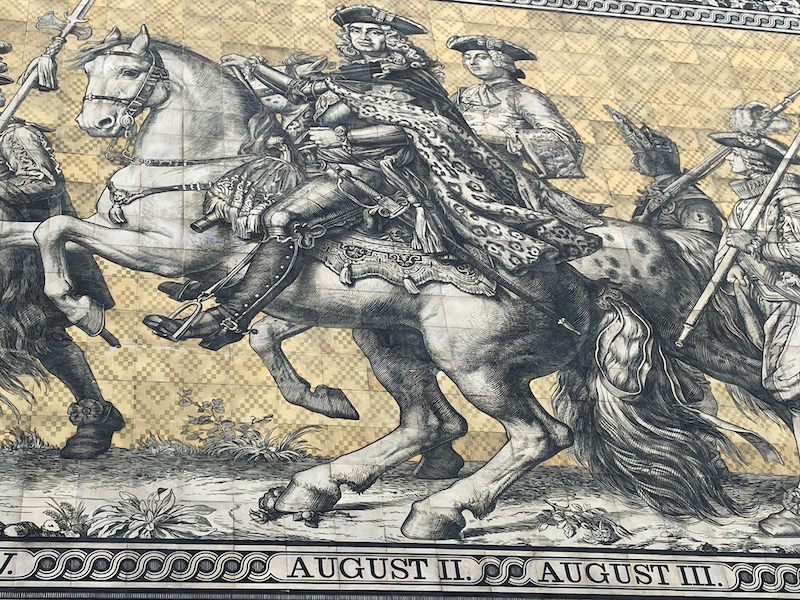
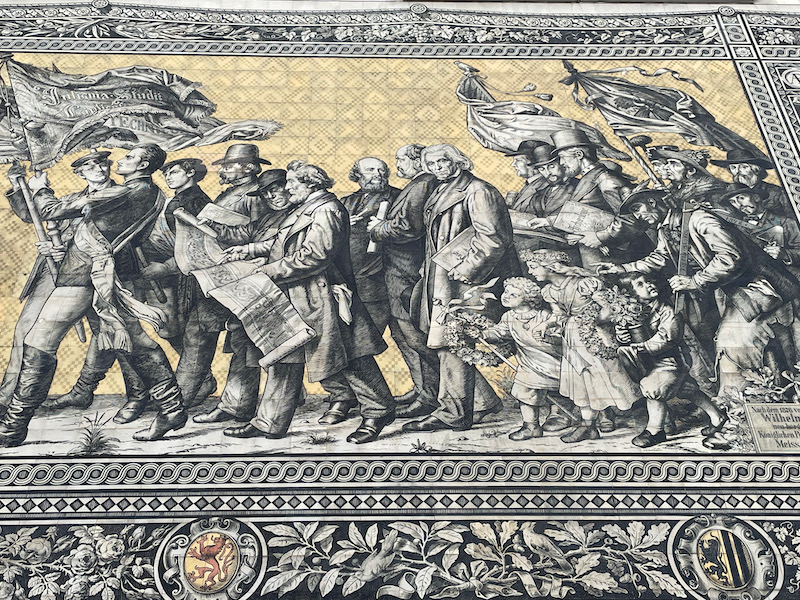
I wanted to try to get a close-up to show that these are actually square porcelain tiles.
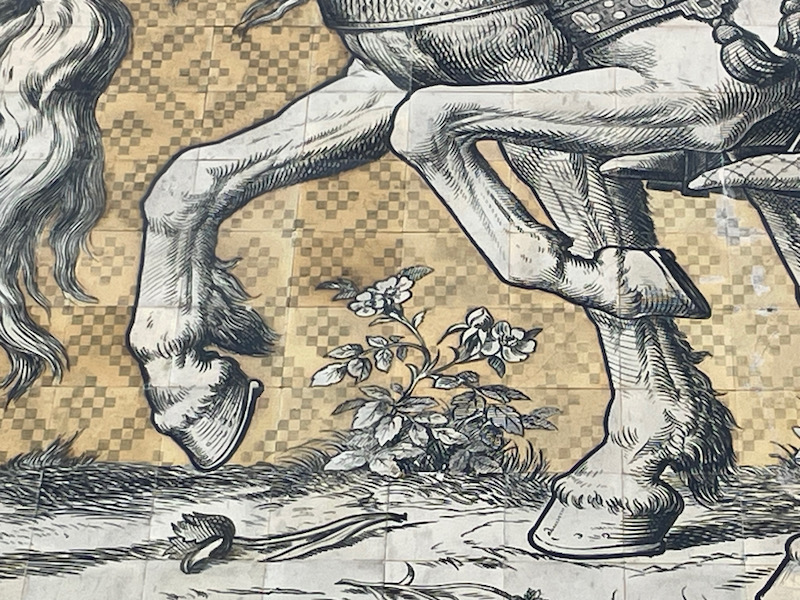
I don't think I have any good pictures of the outside of the Dresden Castle, or Residenzschloss, partly because it is stuck in the middle of the city, surrounded by other buildings. We went inside on the final day to a couple of the museums that are in there, and we went into the courtyard during the tour. It was the residence of the electors and kings from 1547 to 1918. It was rebuilt in 1701 after a major fire by Augustus II the Strong, in a Baroque style. It was almost completely destroyed in 1945 and has been rebuilt. It now houses 5 different museums. During the tour, we went into the large inner courtyard, known as the Great Court. It is surrounded by magnificent Renaissance façades decorated with "sgraffito", which is a technique that has been used in Europe from classical times but popularized in Italy in the 15th and 16th centuries. The wall is covered with layers of 2 different colors and then the artist "scratches off" the top layer, revealing the underlying color. The video pans around the entire courtyard, and then I have a couple closer shots.
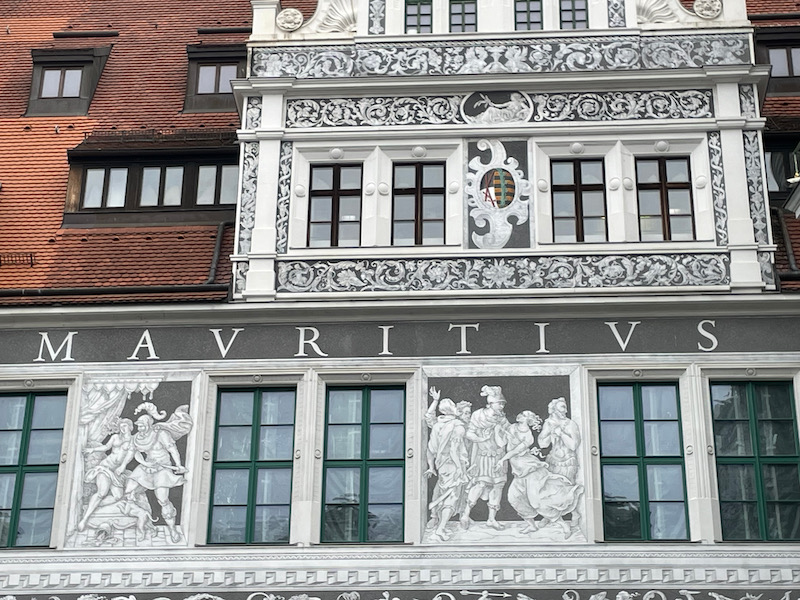
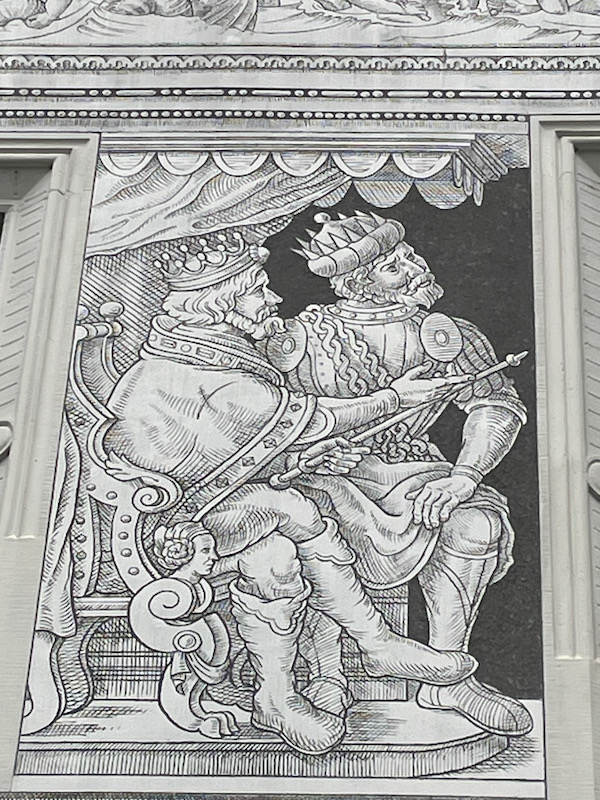
One wall shows the Renaissance fresco of the Altan (a 4-story loggia), which has recently been restored. The frescoes on the Altan are devoted to biblical themes. The 1st floor focuses on the conversion of Paul from the New Testament. The 2nd floor (which I have in the pictures) shows Joseph and Mary with the baby Jesus and the Three Wise Men. The 3rd floor features a scene from the Old Testament: The Queen of Sheba pays her respects to King Solomon.
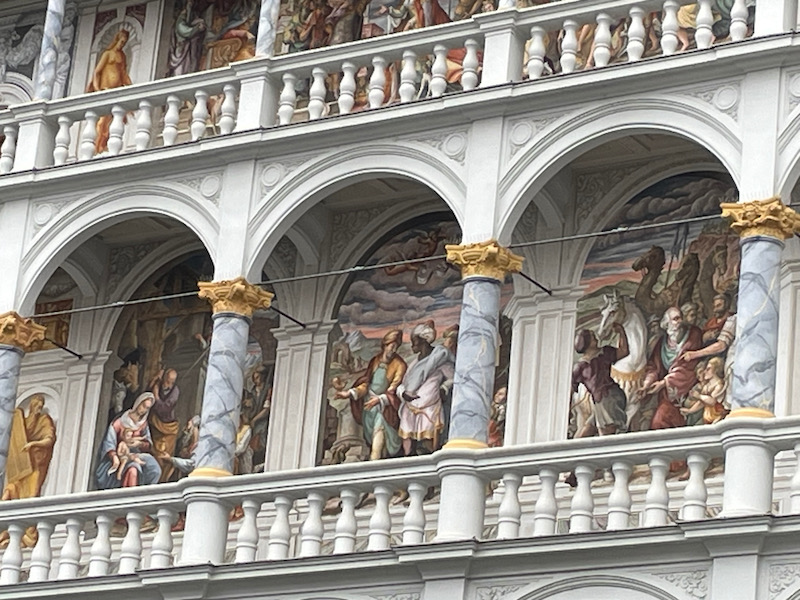
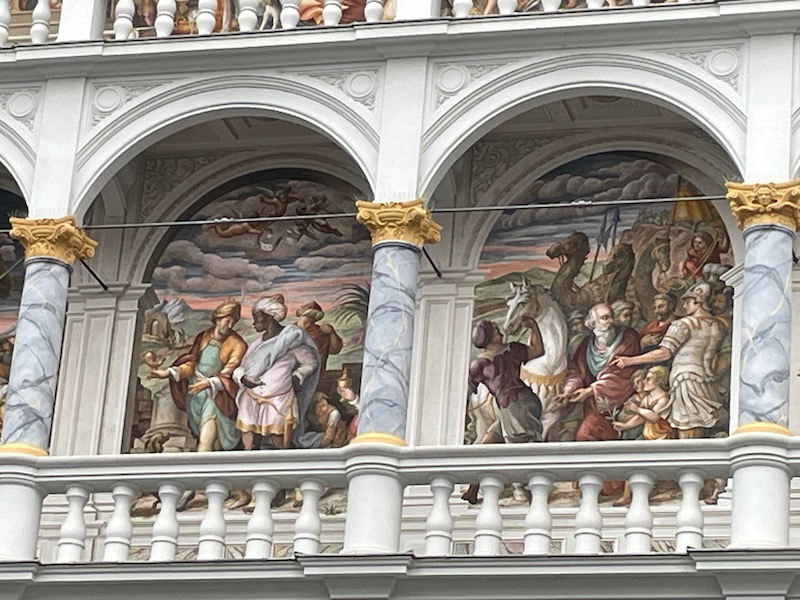
The Palace of Culture was built in 1969 under the East Germany GDR, and it was used for concerts, dances, conferences and other events. The mural on one side, also done in 1969, is entitled "Der Weg der roten Fahne "(The Way of the Red Flag), and is made of concrete slabs electrostatically coated with colored glass. It shows the path to socialism in the style of socialist realism and places the GDR in the context of the historical image of the time. There is a (long article that explains each group of figures) if you are interested, just Google translate it from German to English. Our guide mentioned that some people hate it and some people love it, less for the mural itself but the story that it tells.
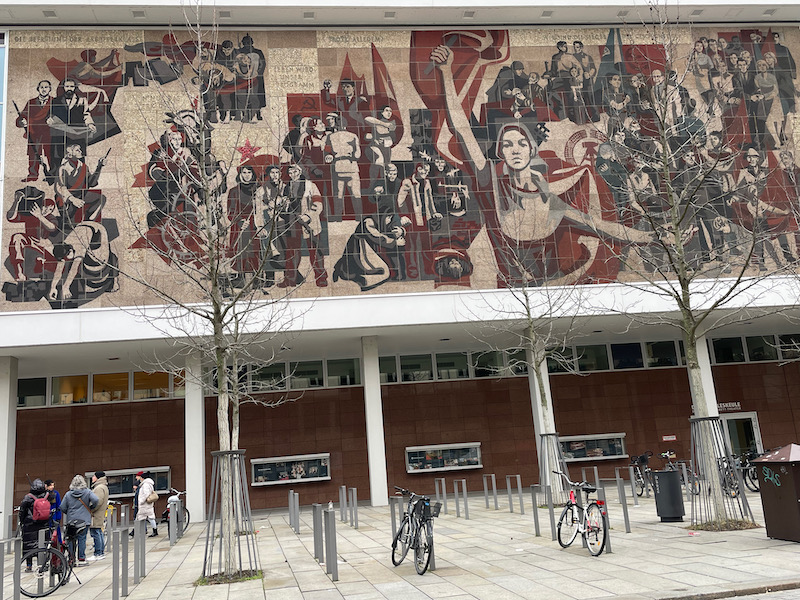
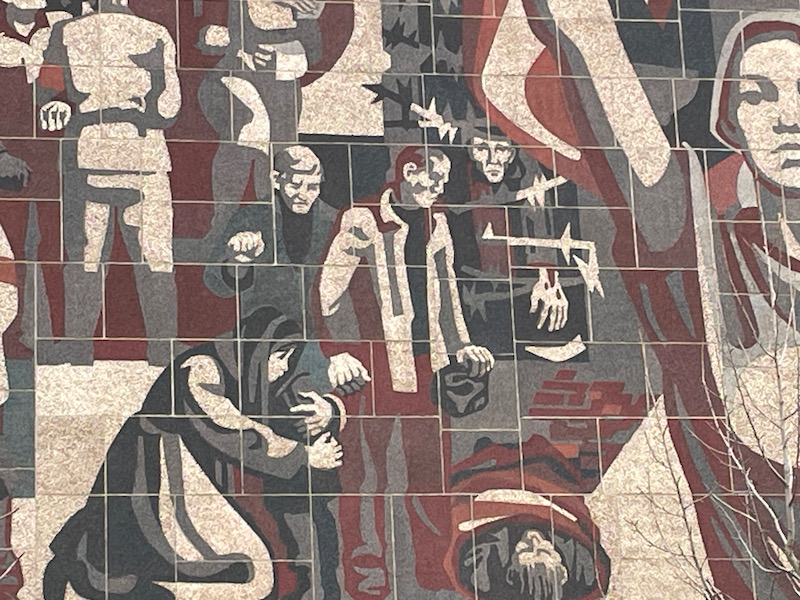
Probably the most recognized church in Dresden is the Frauenkirke, or Church of our Lady. The original church was built in the 11th century in Romanesque style but torn down in 1727 and replaced by a larger church. When it was rebuilt, it was a Protestant church, as that was what the majority of the population was. At the time, the Prince-elector, Frederick August I, had converted to Catholicism in order to become King of Poland. But he supported the construction of the new Protestant church because he wanted to reassure the population that he wasn't going to force Catholicism on them. Like most buildings that were constructed during that time, it was a Baroque-style church. It held out for 2 days of bombings with the temperatures reaching 1,830 °F before the dome finally collapsed, the pillars exploded and the outer walls shattered. If you would like to see what was left, there is a good picture from 1958 on Wikipedia that shows what was left. Residents started salvaging the stone fragments and numbering them, hoping that it would be rebuilt. The rebuilding took place between 1994 and 2005, using the original plans from 1720. Many of the salvaged blocks were reused. The darker blocks are the original ones and you can see that the 2 side parts are almost completely original blocks (which you can also see on the picture from 1958, the 2 parts on the sides that remained when the dome collapsed.
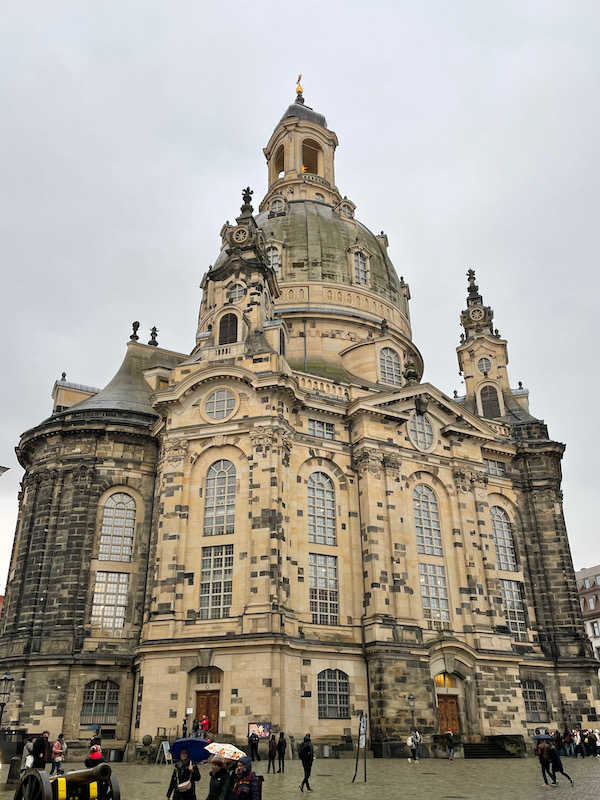
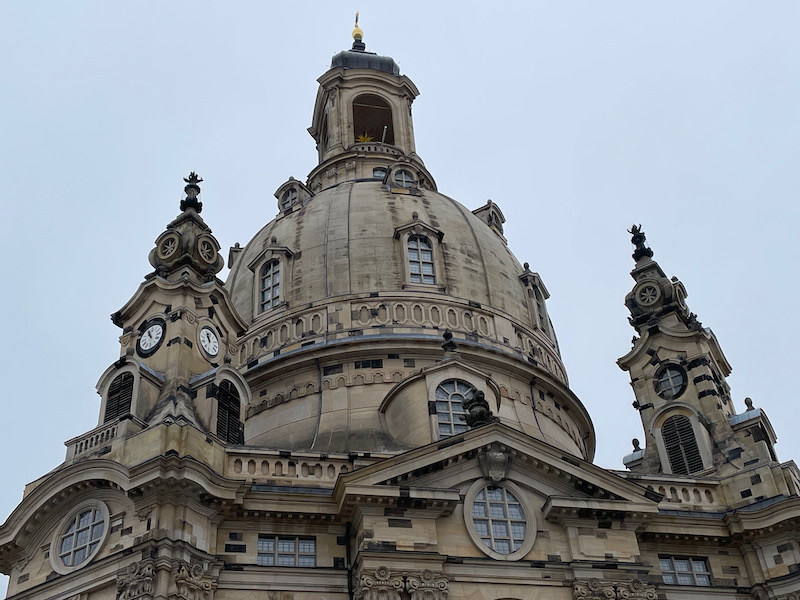
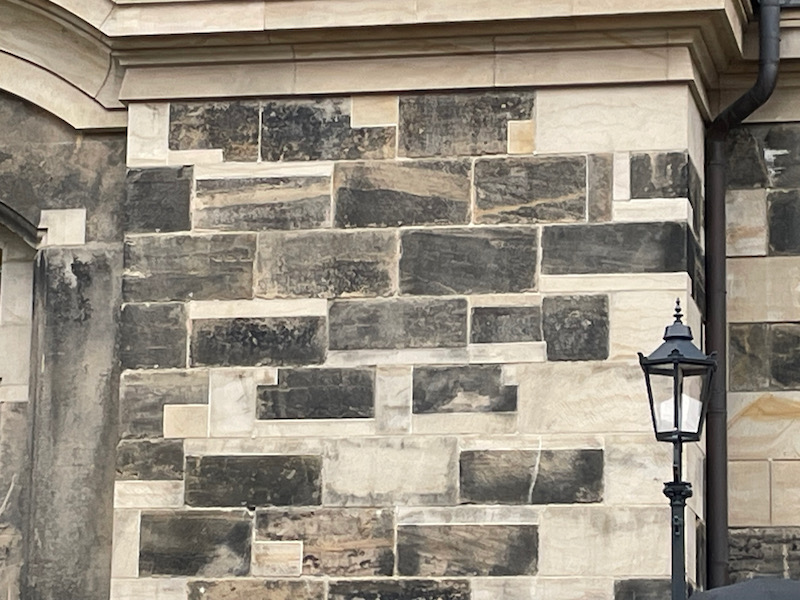
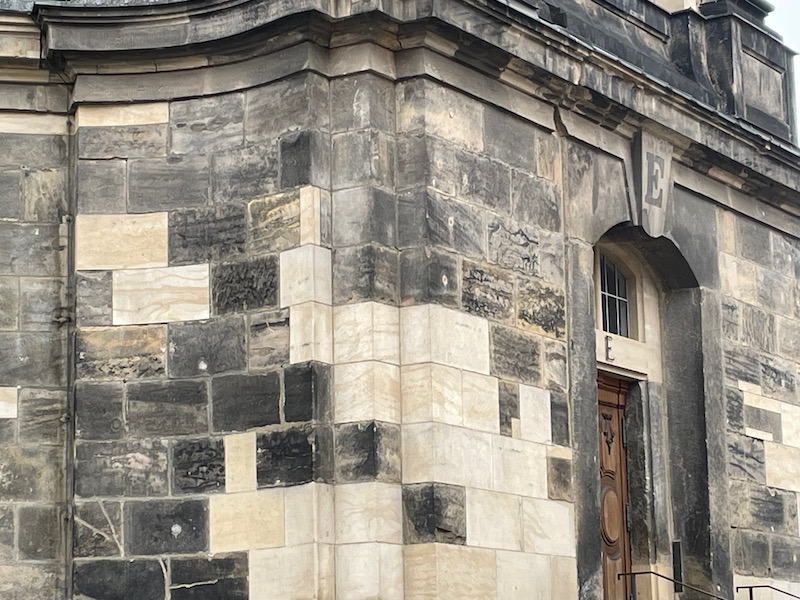
The interior (to me) looks more like a concert hall than a church, with the exception of the huge altar topped by the organ. Interestingly enough, the core piece of the altar is original ... it was salvaged from the rubble of the old Frauenkirche and deliberately reused in the new building, despite its damage. On the larger figurative level of the altar, next to the central scene with Jesus on the Mount of Olives, two people from the New Testament and two people from the Old Testament are depicted: on the far left is Moses with the tablets of the law, in the middle left is Paul with his sword and book, in the middle right is Philip with the cross, and on the far right is Moses' brother Aaron as a priest wearing a breastplate. The paintings in the inner dome were originally created in 1734 depicting the evangelists Luke, Matthew, Mark, and John as well as portraits of the Christian virtues faith, hope, love, and mercy. These were recreated during the rebuilding.
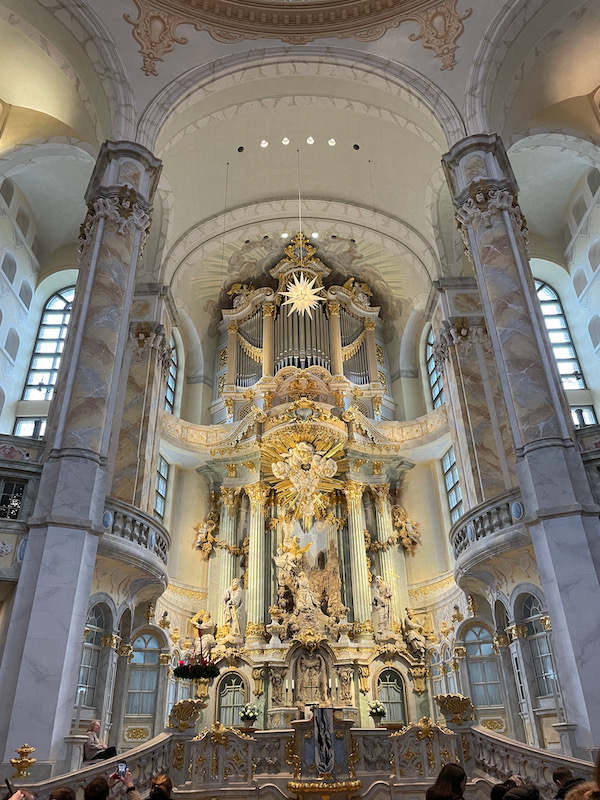
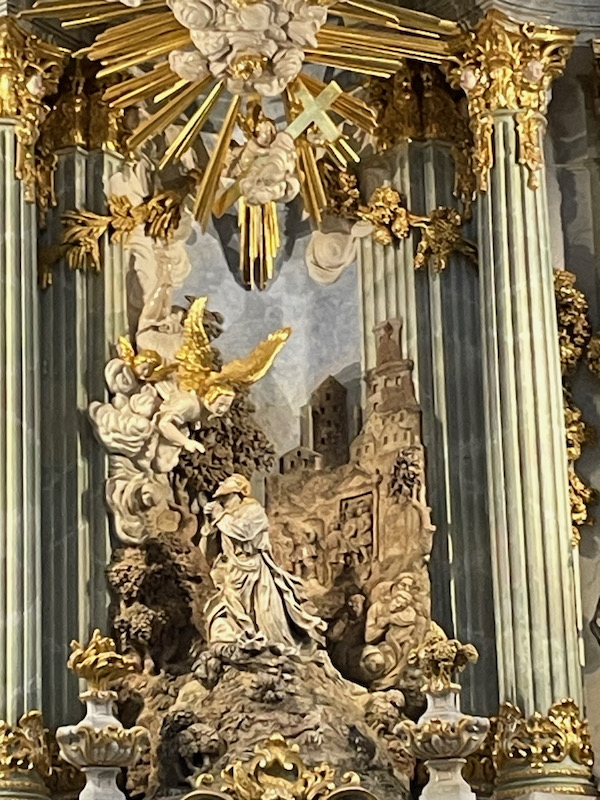
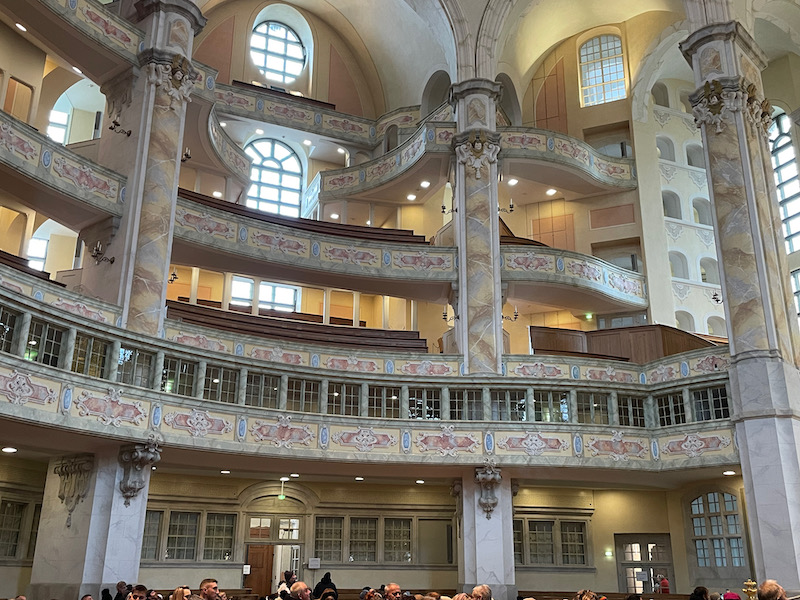
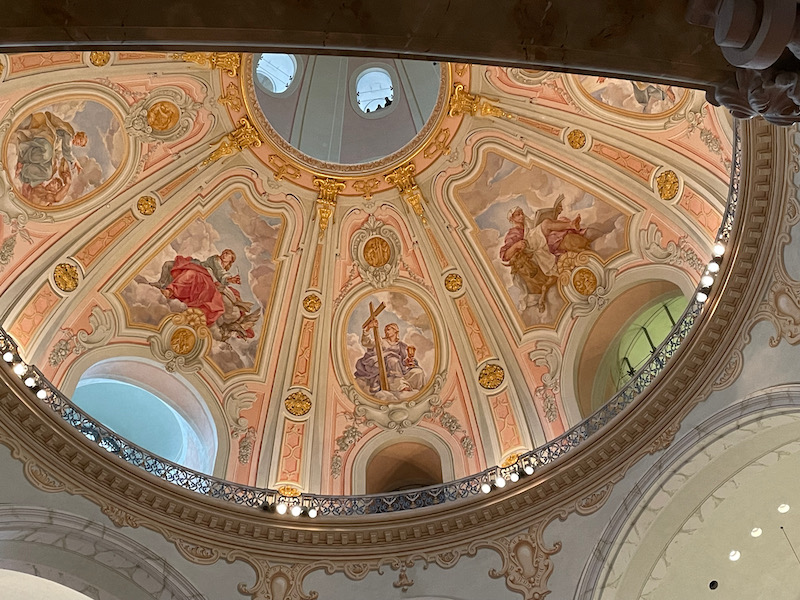
I mentioned there are several Christmas markets in town, this one is called the Weihnachtsmärkte, sitting below the Frauenkirke. The night pictures shows an 8-meter-high walk-in Christmas pyramid with hand-made wooden figures.
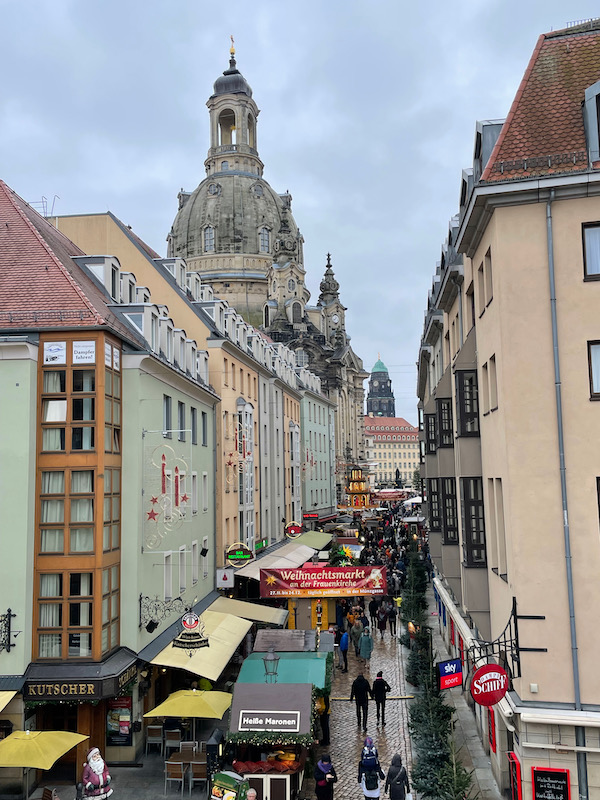
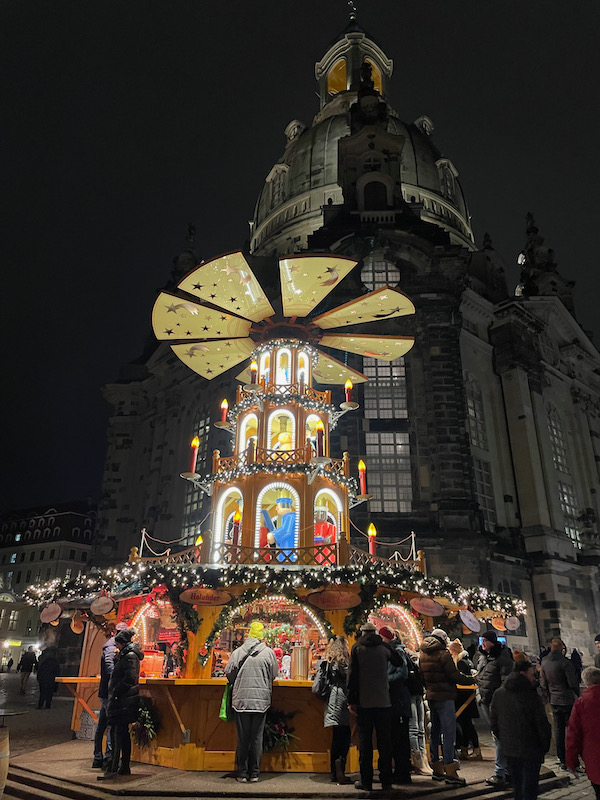
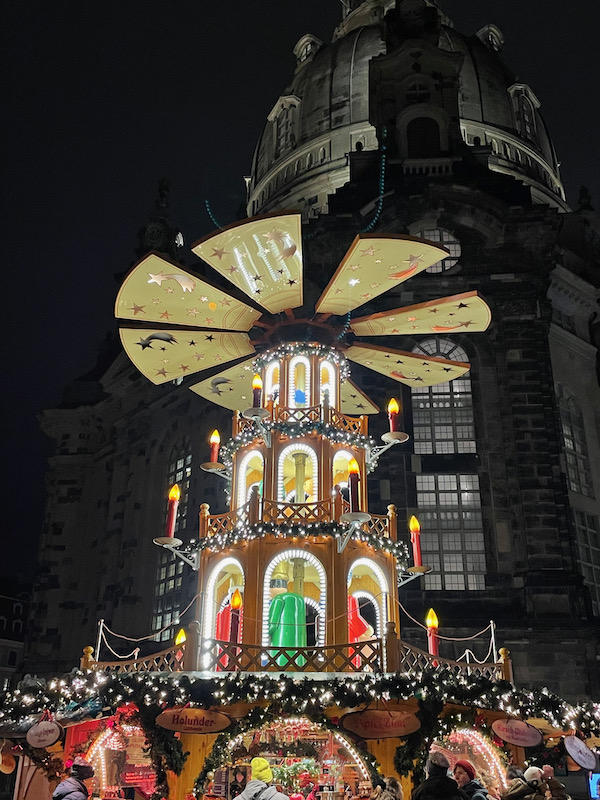
The Dresden Cathedral commissioned by Augustus III, the Elector of Saxony and King of Poland between 1739 and 1751. Remember that his father, Augustus II, converted to Catholicism so that he could become King of Poland. The population of the city remained Protestant (worshipping in the Frauenkirke), so the cathedral for use by the king and other high-ranking officials who were Catholic. On the façade and balustrades of the Baroque cathedral are 78 statues of saints.
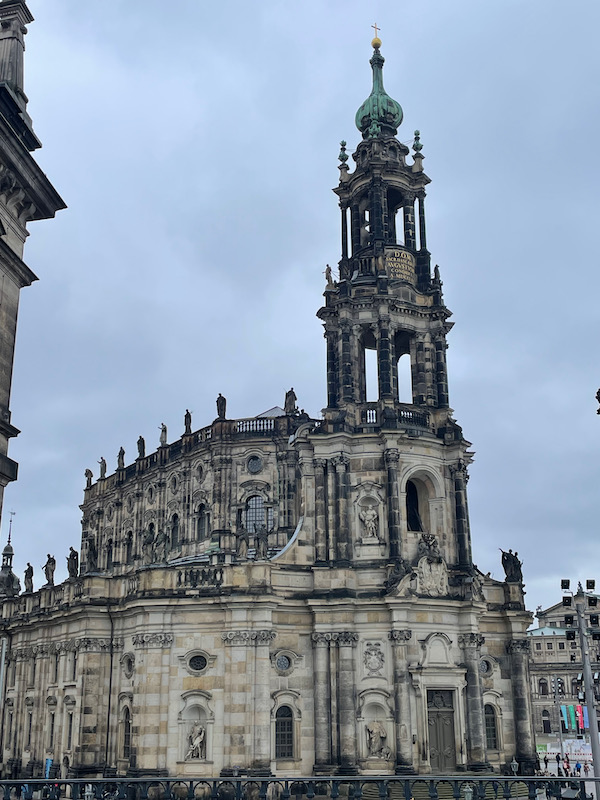
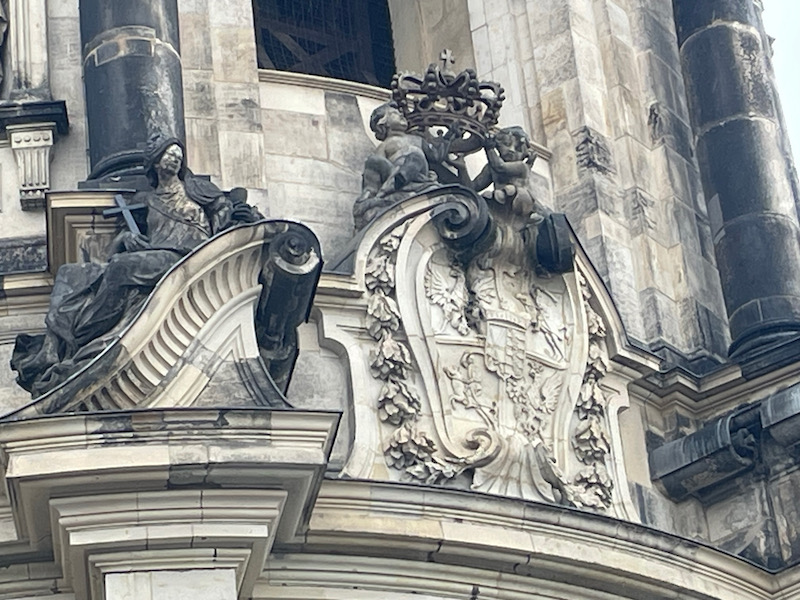
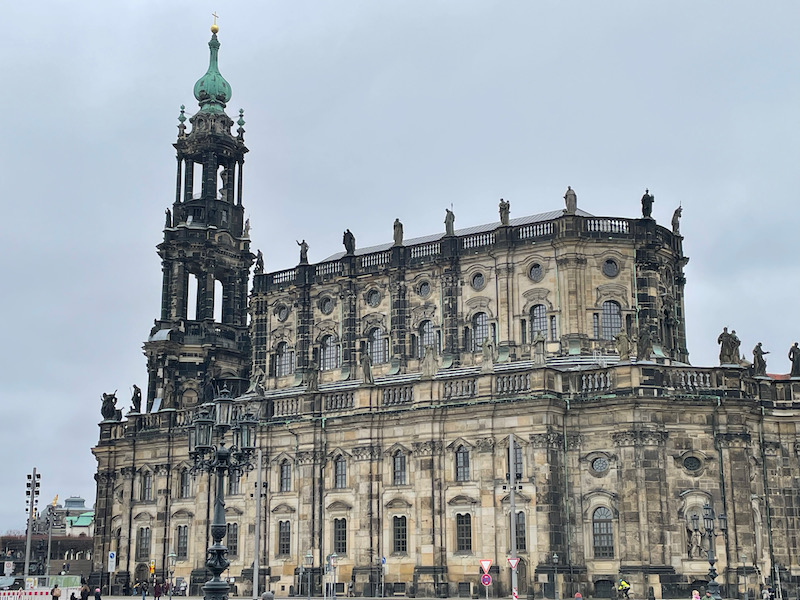
Augustus III also built a walkway between church and the Residenzschloss (Royal palace) which was restored.
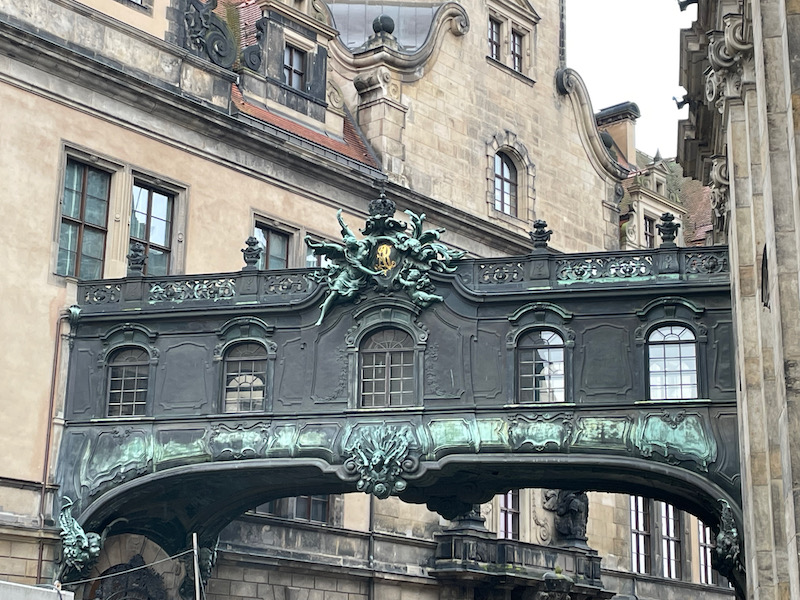
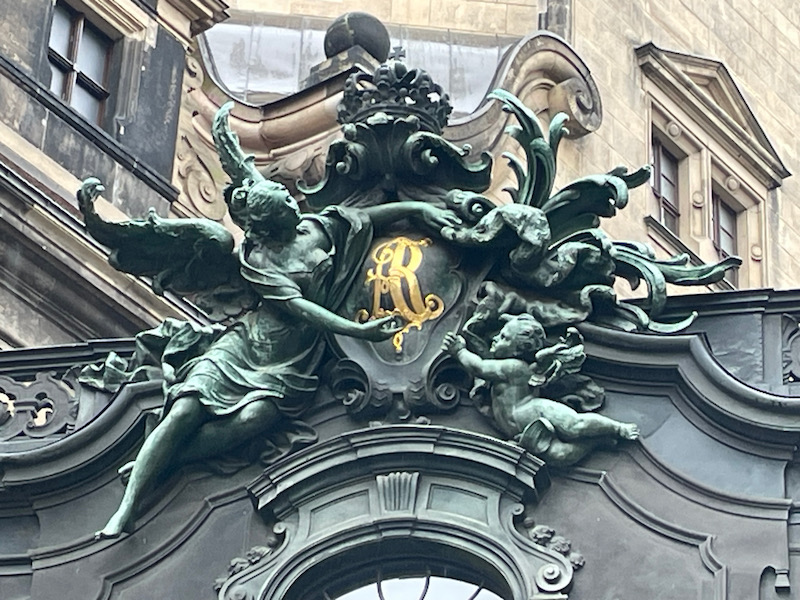
The interior is divided into a main nave, two side aisles and four corner chapels. On the right-hand side of the nave is a carved Baroque pulpit, which was created in 1712. The high altar was created from marble and gilded bronze ornaments. Above it is the altar painting, created between 1752 and 1761, which depicts the Ascension of Jesus Christ.
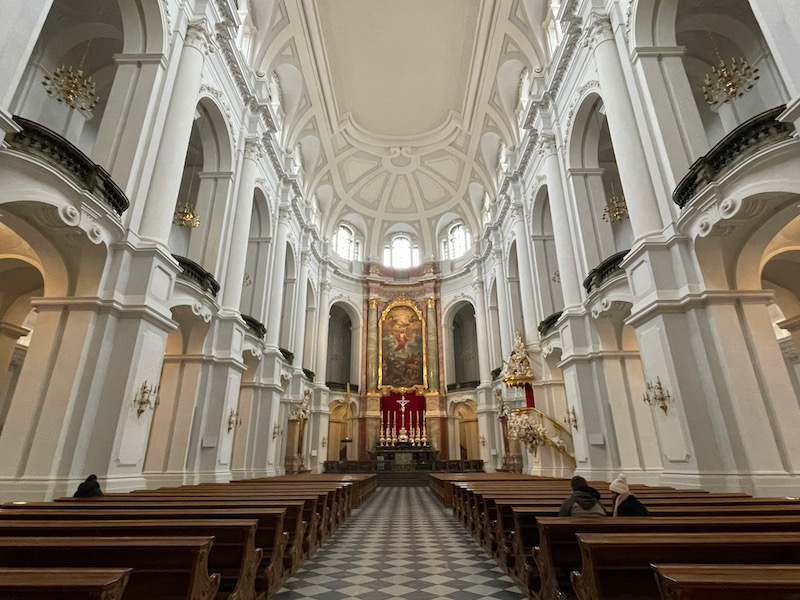
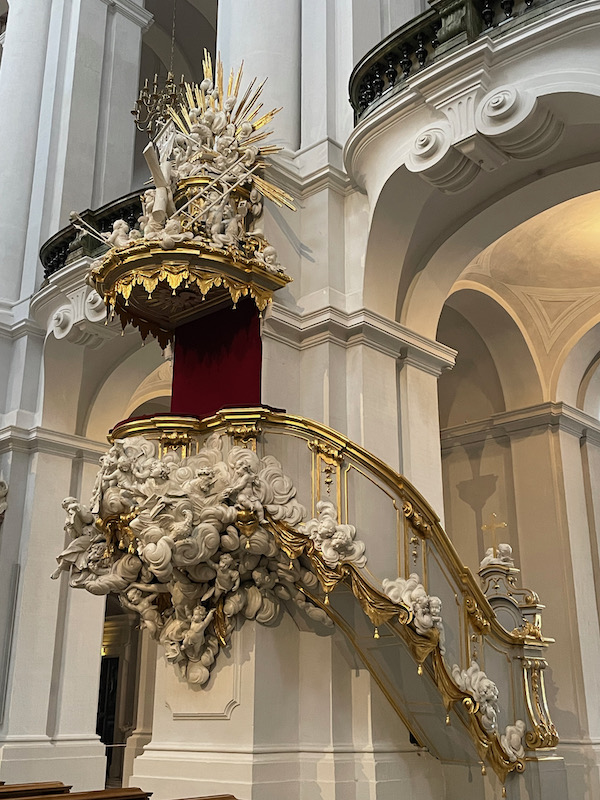
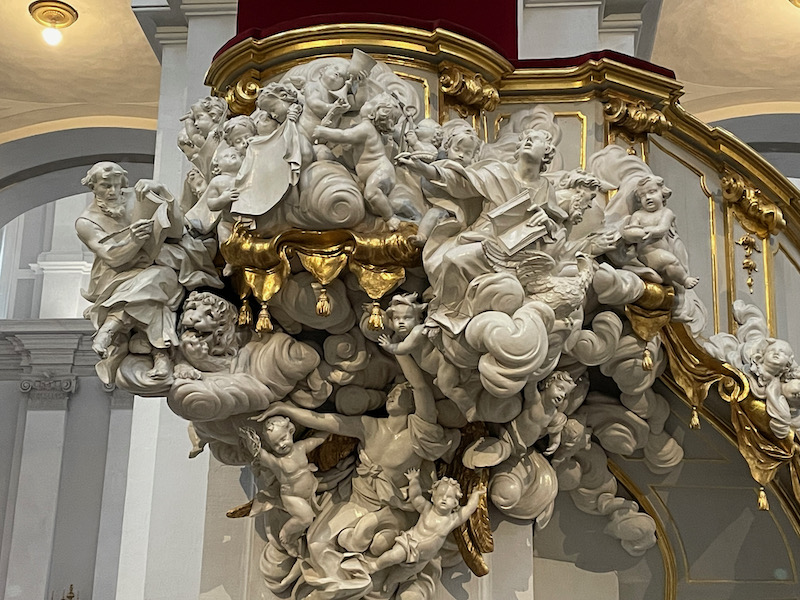
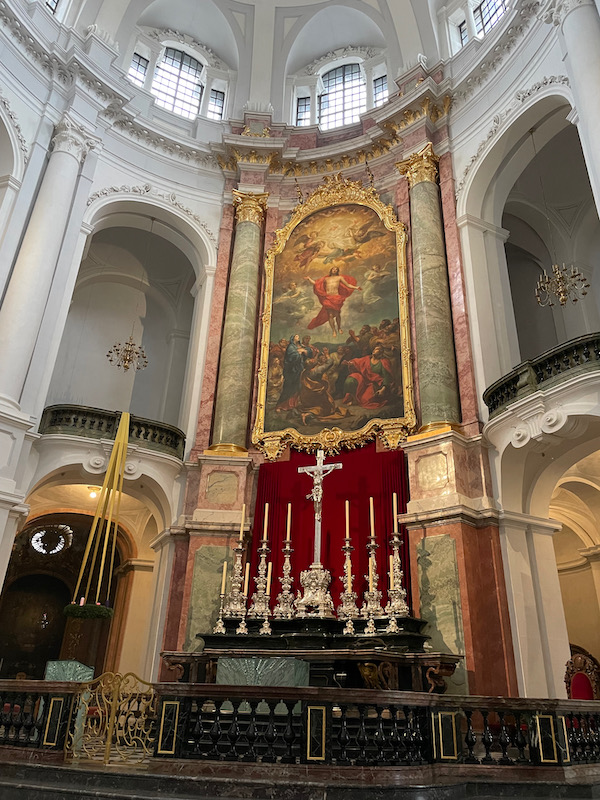
The Georgentor was built in 1902 at the site of an earlier gate. It was the first Renaissance building in the city and is is named after George the Bearded, who commissioned it and whose equestrian statue decorates the center of the front façade.
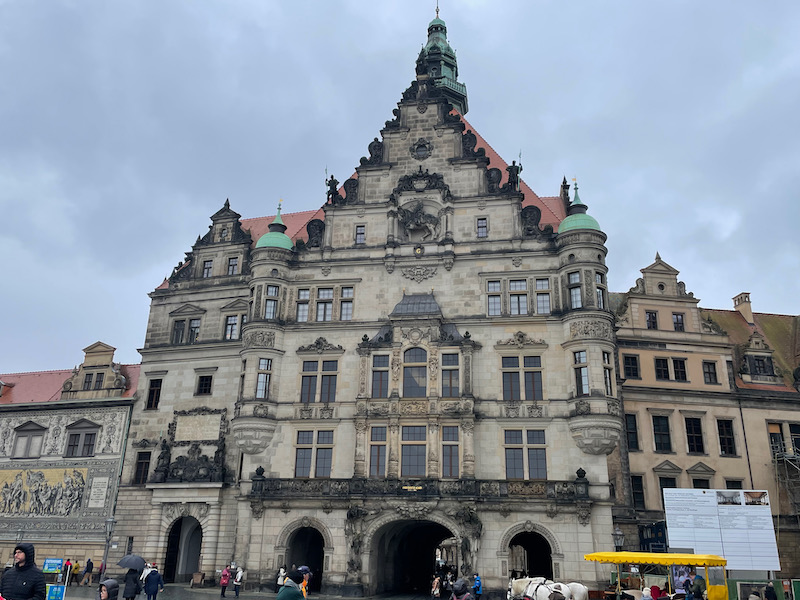
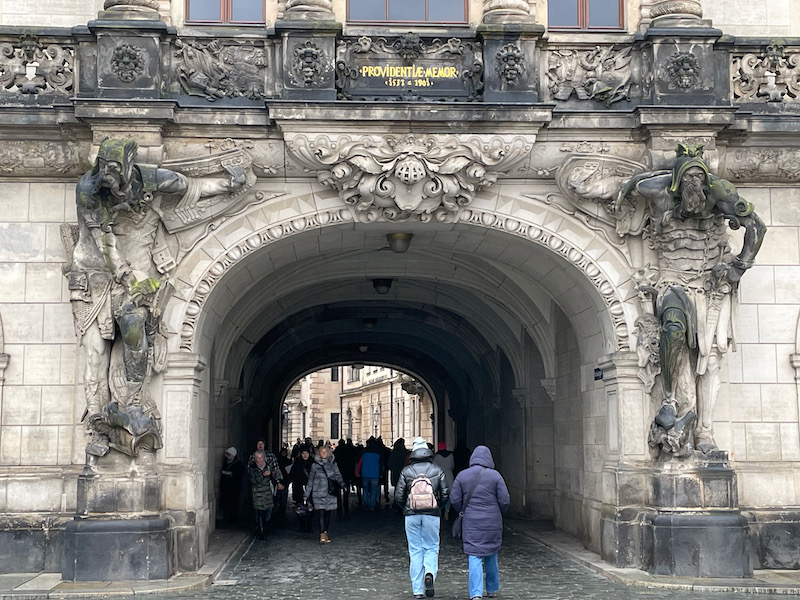
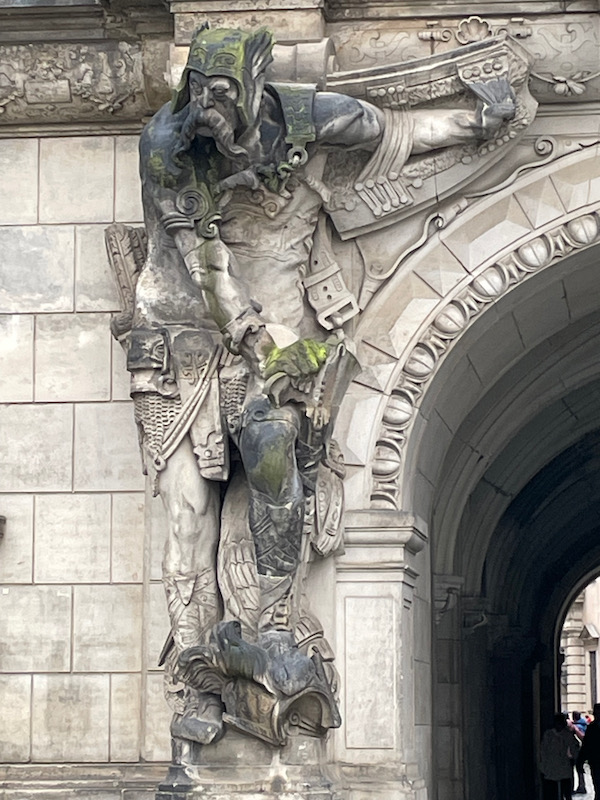
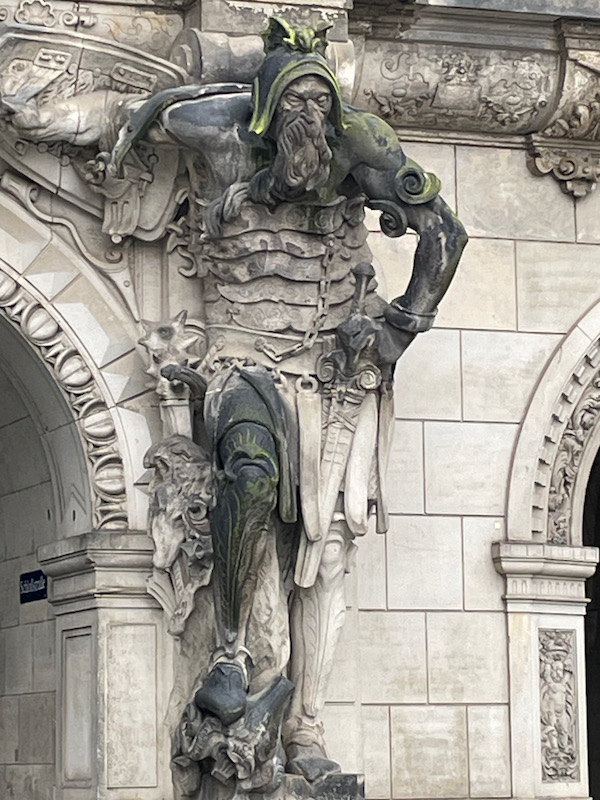
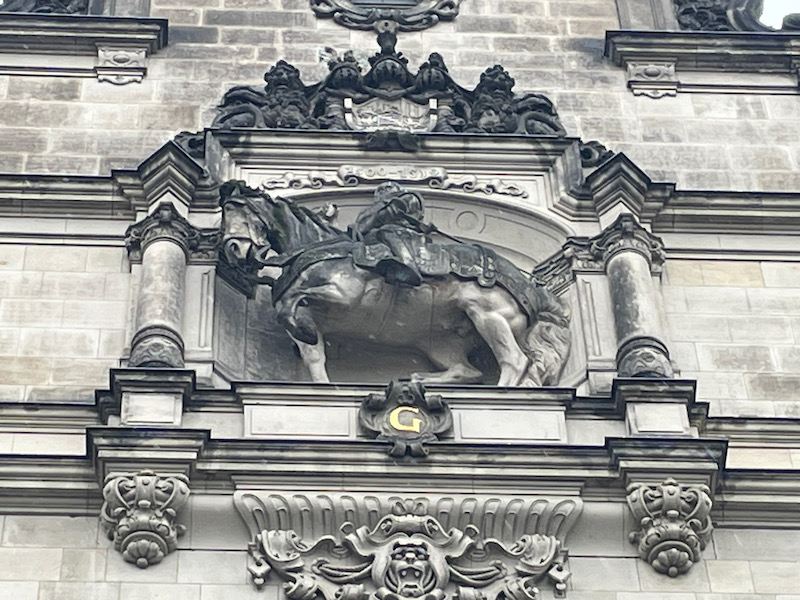
I'll just give a peek at the Semperoper Opera House, which was originally built in 1841 and reconstructed in 1985. You'll get lots more on this in Day 3 when we did a guided tour of the interior.
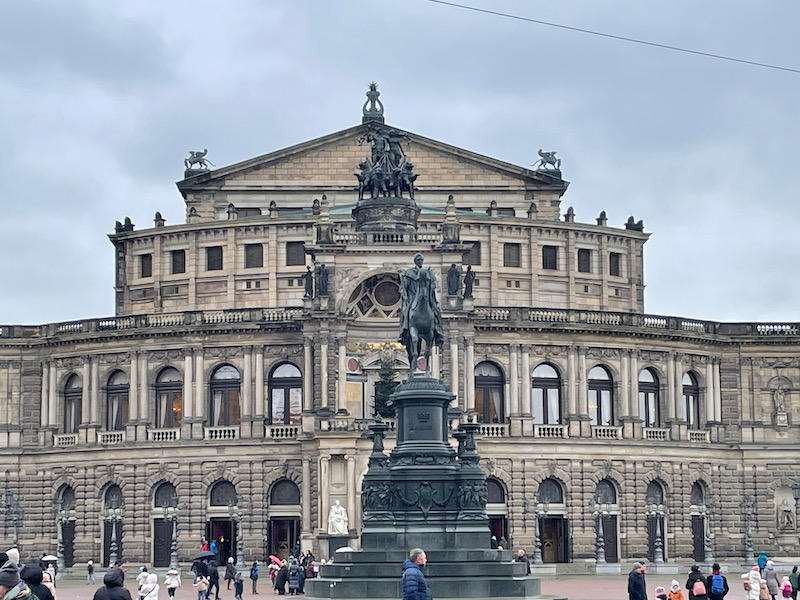
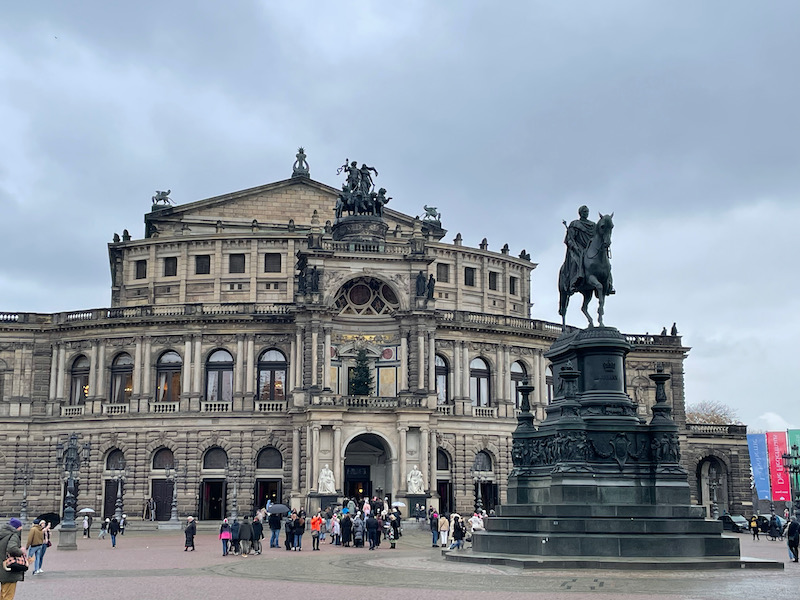
While the castle was originally built in 1200, the Zwinger Palace was built in 1709 as an orangery and garden. Orangeries were very popular with royalty because it allowed them to showcase their wealth and power. Citrus trees were popular but in many places in Europe, they were unable to survive the cold winters. They are normally very tall and faced South. In winter, when the sun is low, it brings direct light and heat to the room. In summer, when the sun is directly above the building, it does not enter directly so it doesn't get too hot. Additional galleries and courts were planned but abandoned after the death of Augustus II the Strong. The galleries were finally opened in 1855 and various museums were located there.
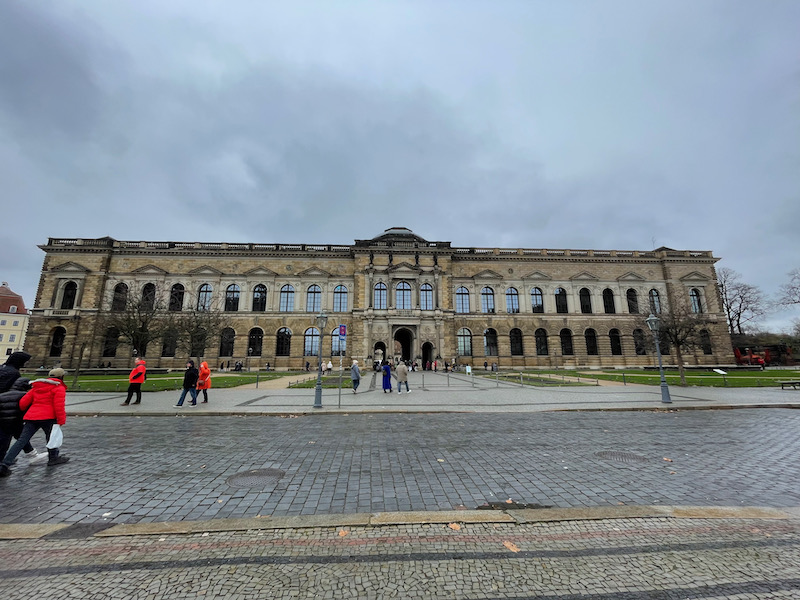
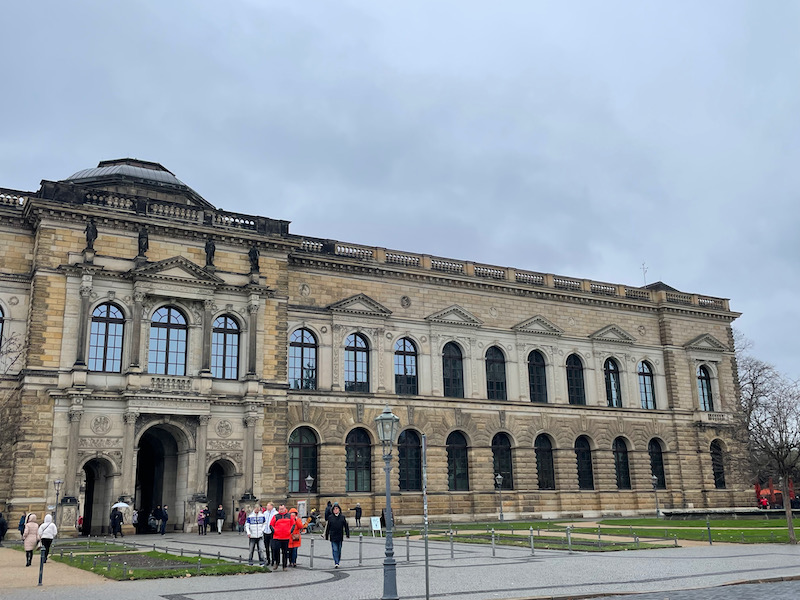
On the other side of the gardens is the Kronentor, an 18th century Baroque gateway topped with an ornate crown marking the entrance to a palace complex. You can see that there is quite a bit of work going on in the gardens, which makes sense in the winter. But you can see the large pavilions on all sides, which is where most of the museums are located.
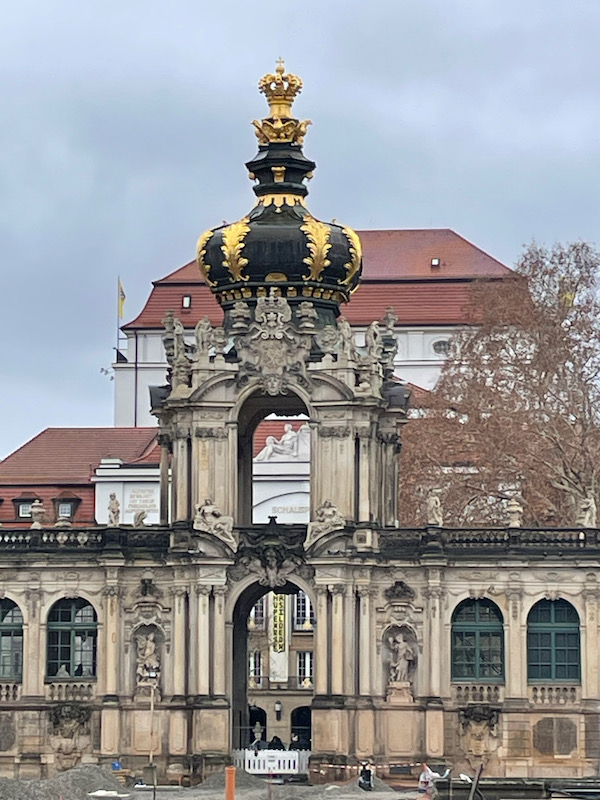
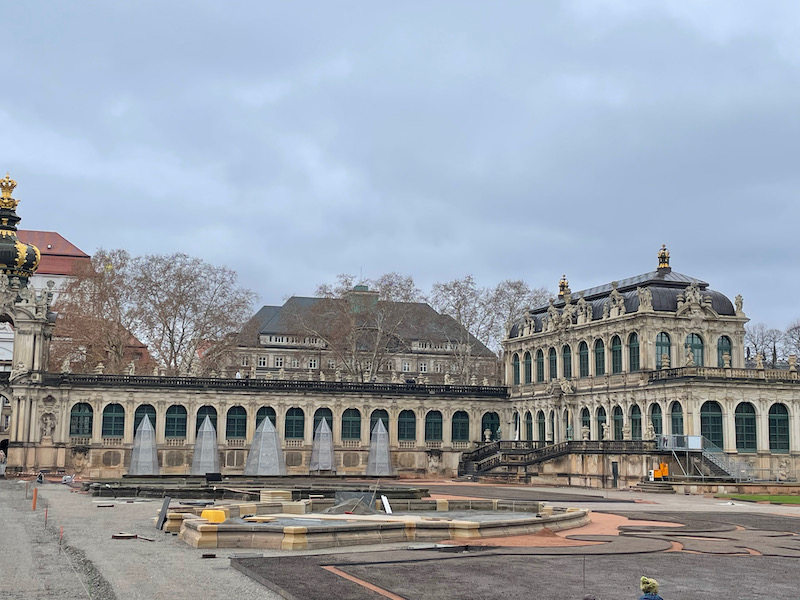
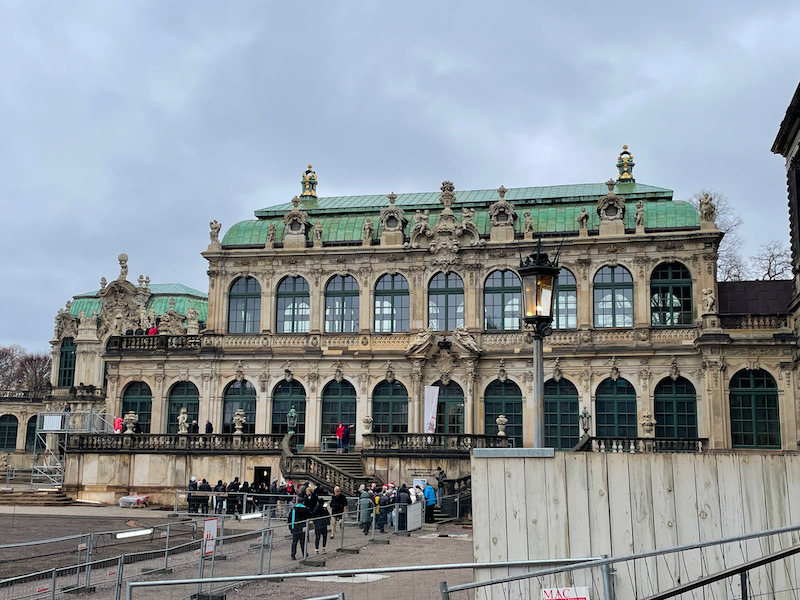
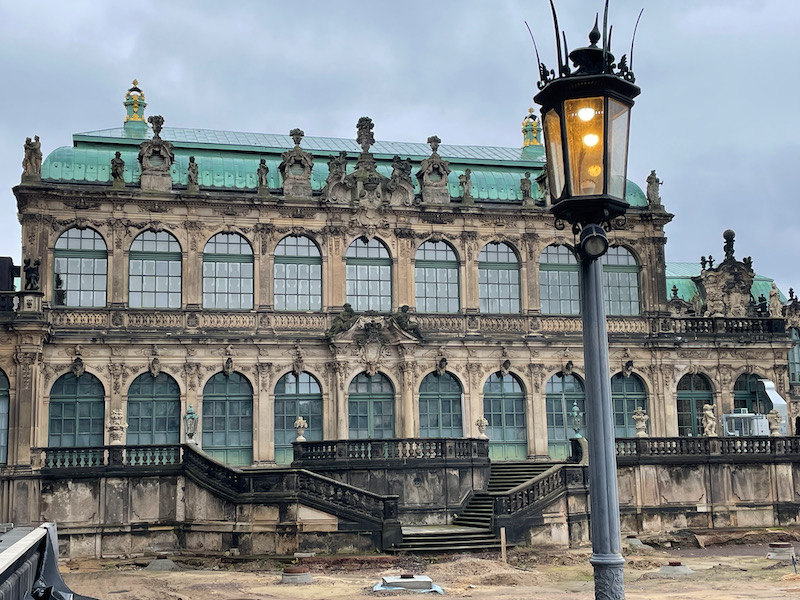
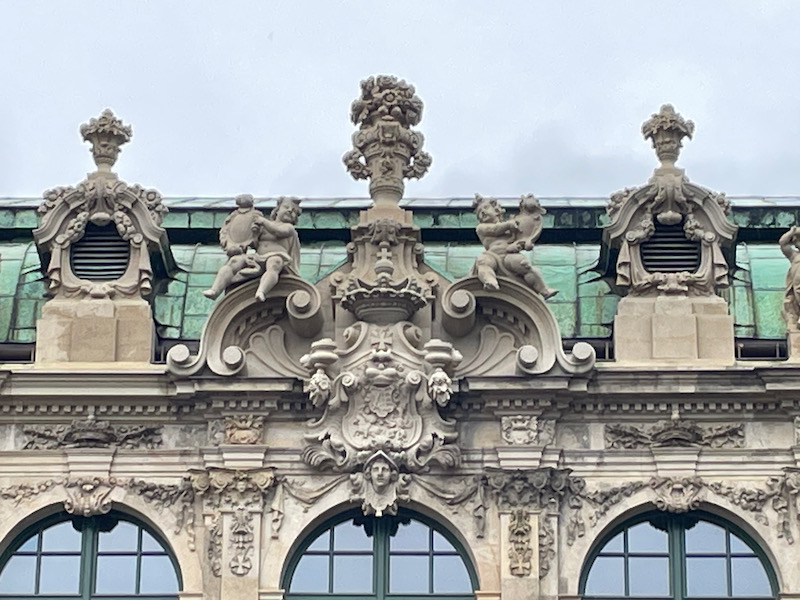
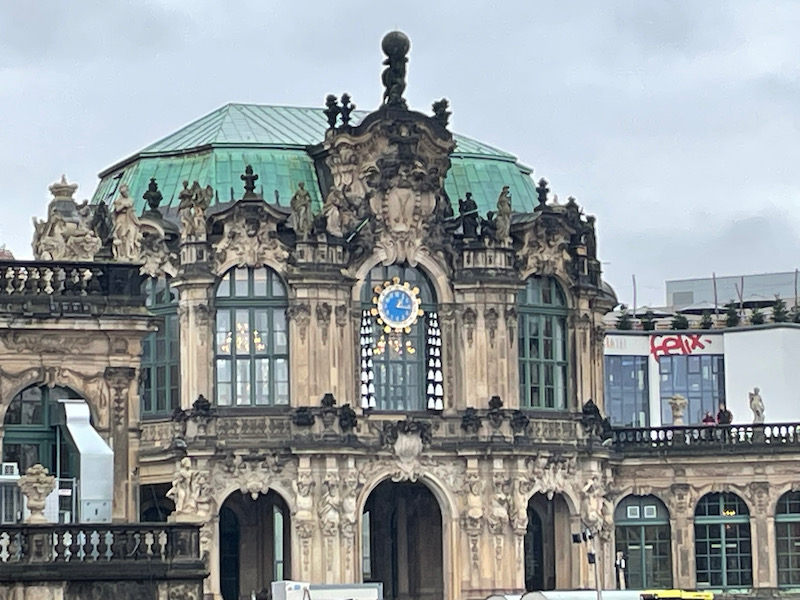
We like to try foods that are very typical of the region or city, and this trip was no different. In addition to the dinners that we had, we also stopped for Quarkkeulchen, pan-friend sweet cheese dumplings. The dough contains grated potatoes and a cheese called "quark", a type of cream cheese that has a high protein content making it a popular cheese for bodybuilders. As a dessert, it is normally seasoned with cinnamon, sugar and lemon zest.
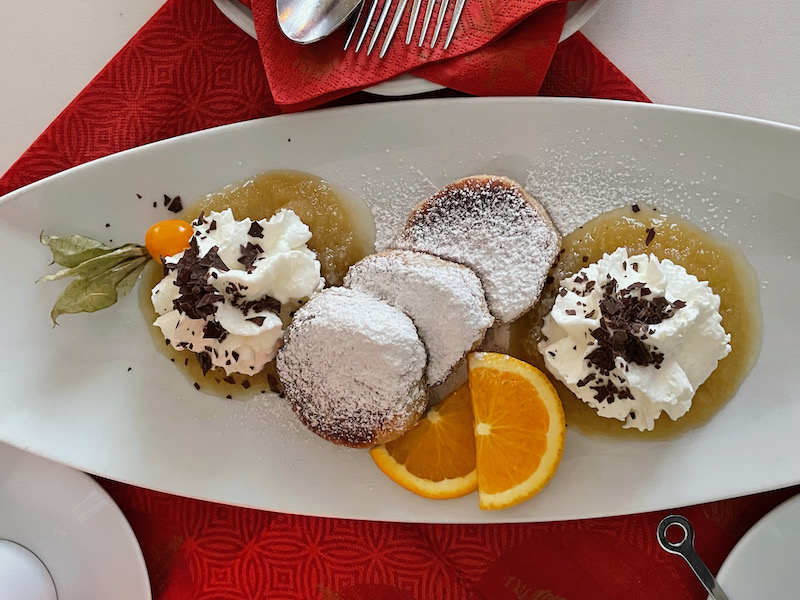
The Dresden Academy of Fine Arts was established in 1764 and the main building was built in 1894. The glass dome is known as Lemon Squeezer due to its form, and the building has been heavily reconstructed and renovated since World War II. It is quite a large facility with really elaborate decorations and statues, and a few shiny gold statues on the top.
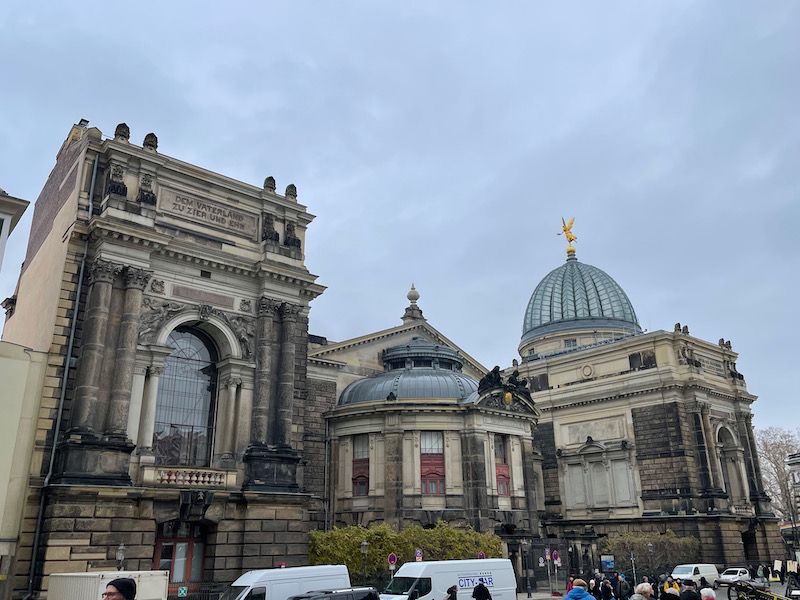
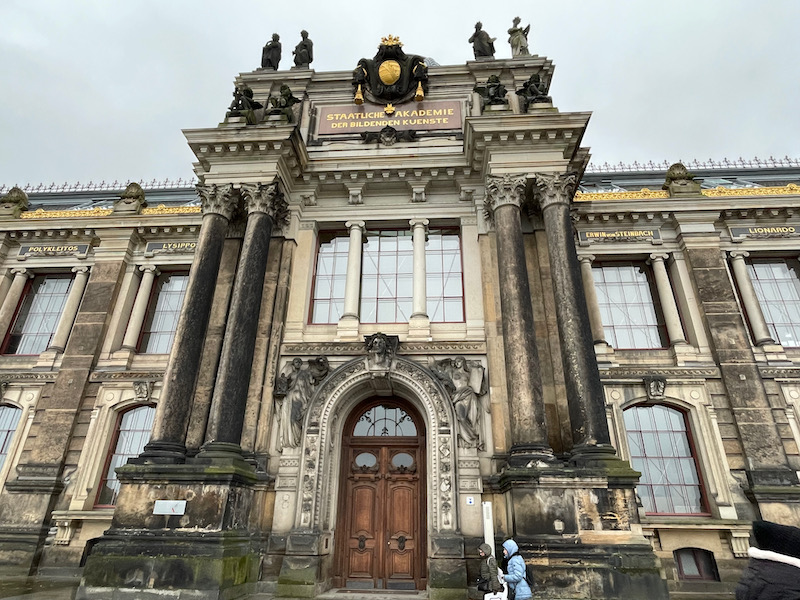
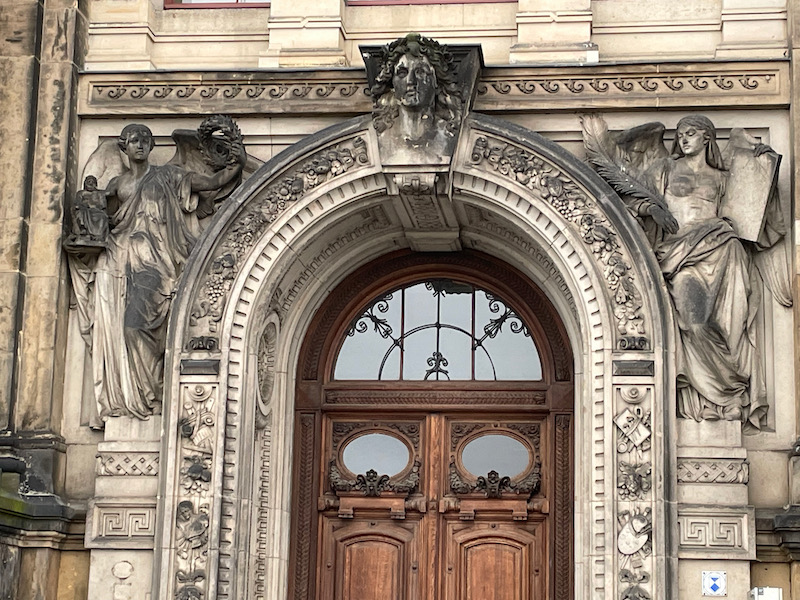
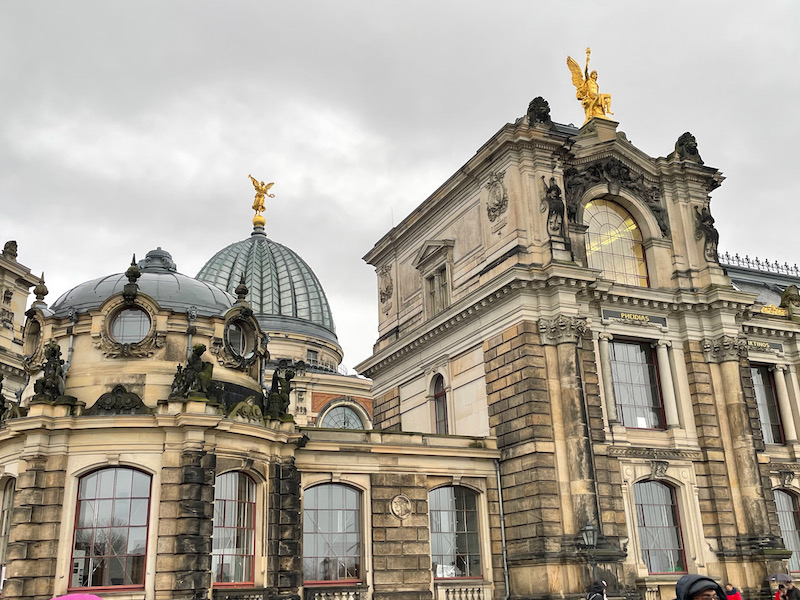
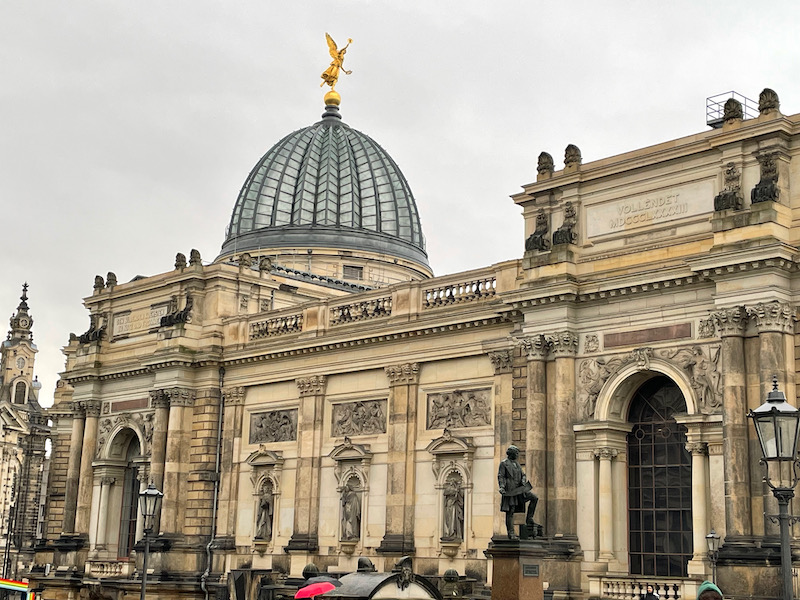
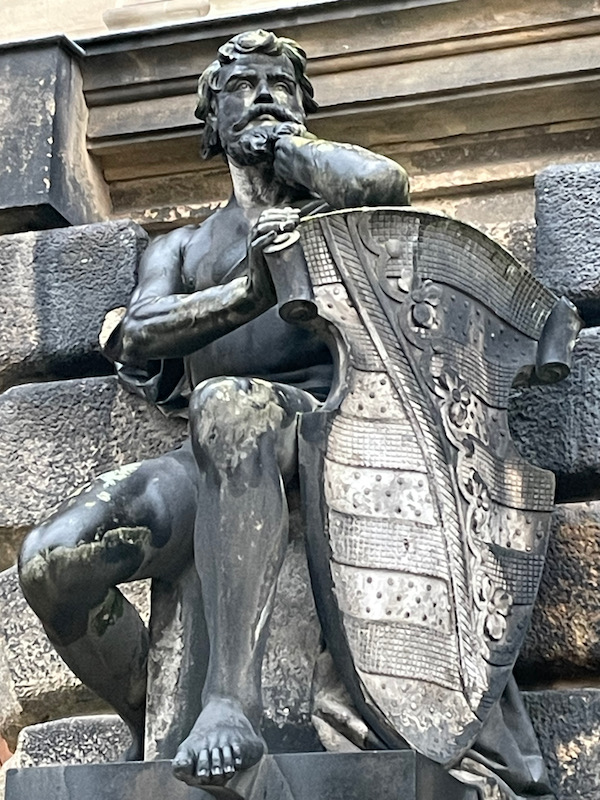
This gives an idea of the fortifications along the river at the Fine Arts Academy.
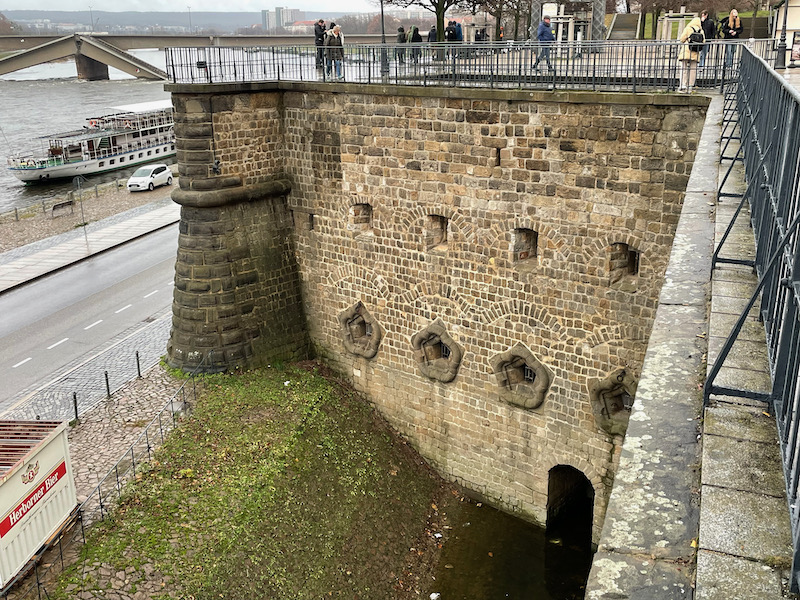
The Kreuzkirche (Church of the Holy Cross) is the main church of the Evangelical-Lutheran Church of Saxony, and the largest church building in the Free State of Saxony. It also is home of the Dresdner Kreuzchor boys' choir.
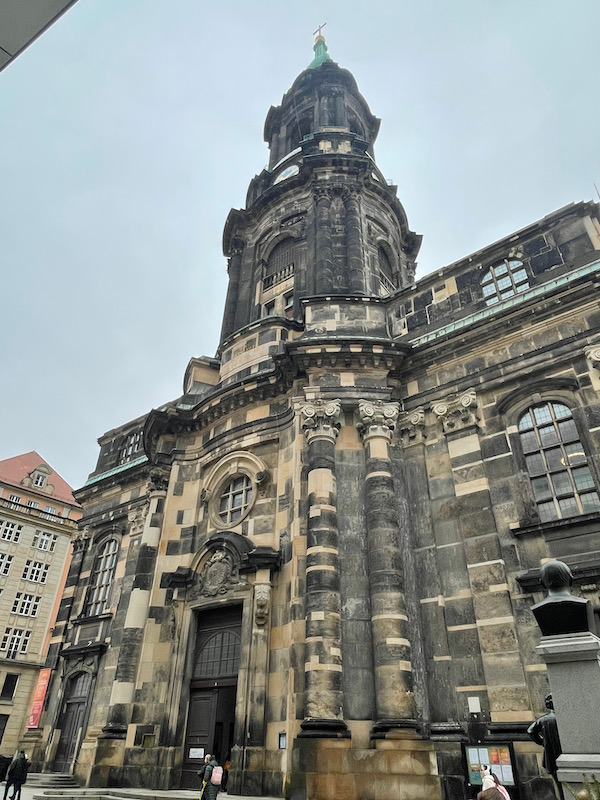
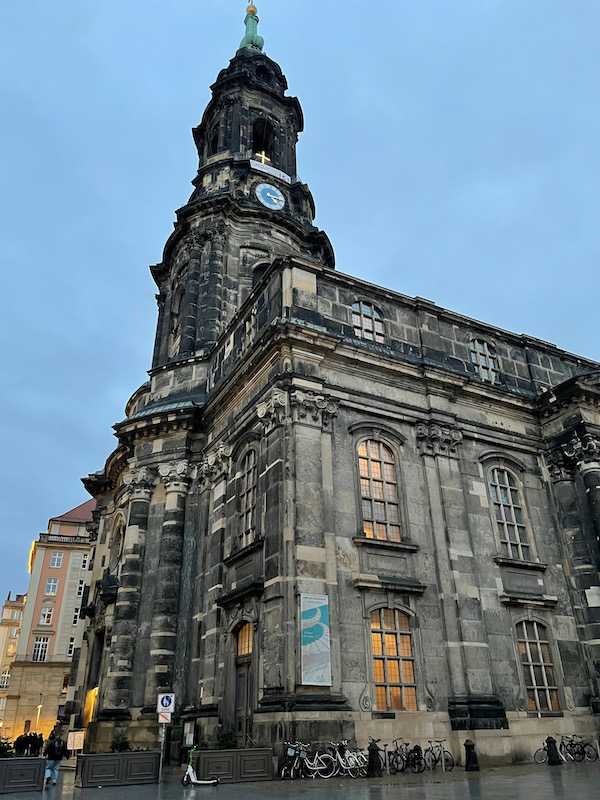
The interior is a baroque central space on a square floor plan with an adjoining semicircular choir. The altar is the only thing that remains of the church from before the Bombing of Dresden. It depicts the crucifixion of Christ and was created in 1900. The bronze relief above the altar table, which depicts the first Lutheran service in Dresden in the Kreuzkirche in 1539. was also created in 1900.
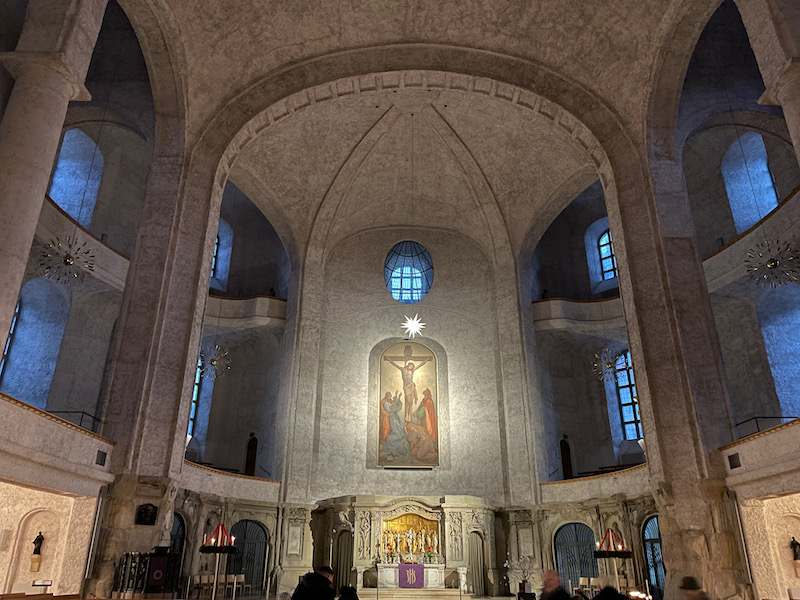
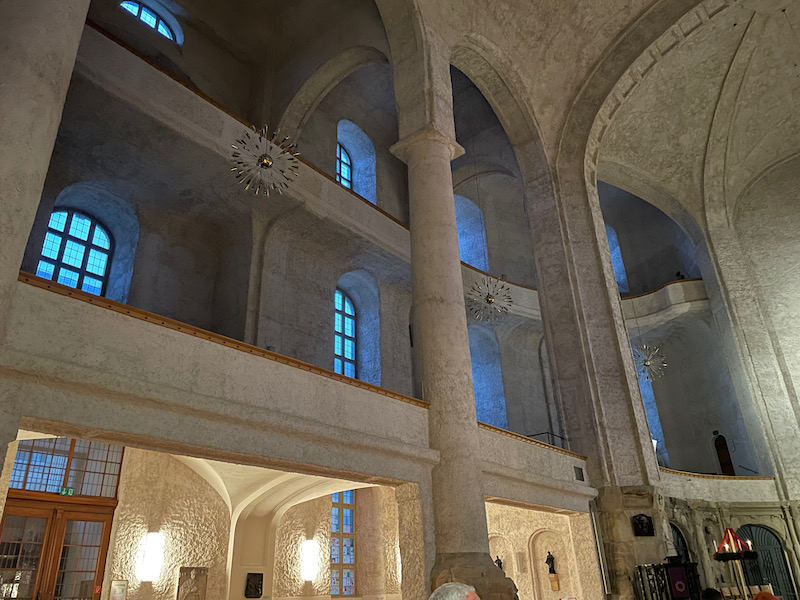
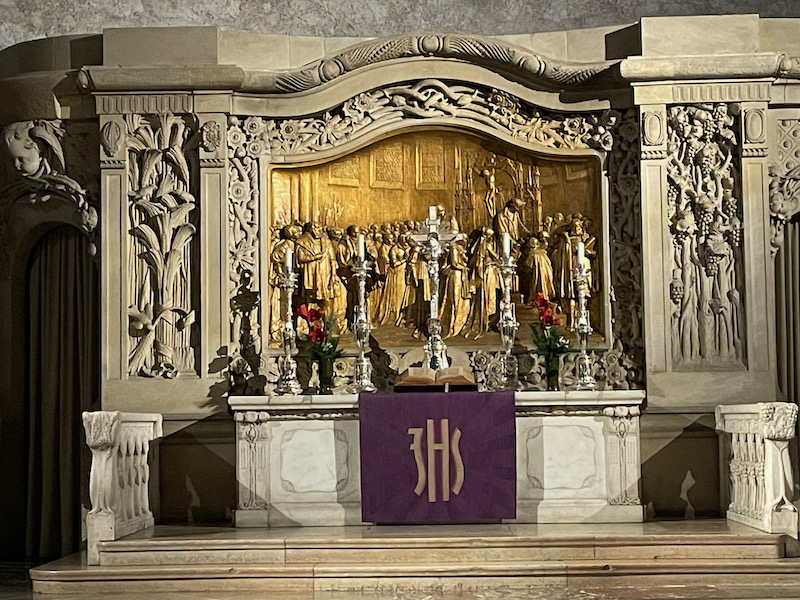
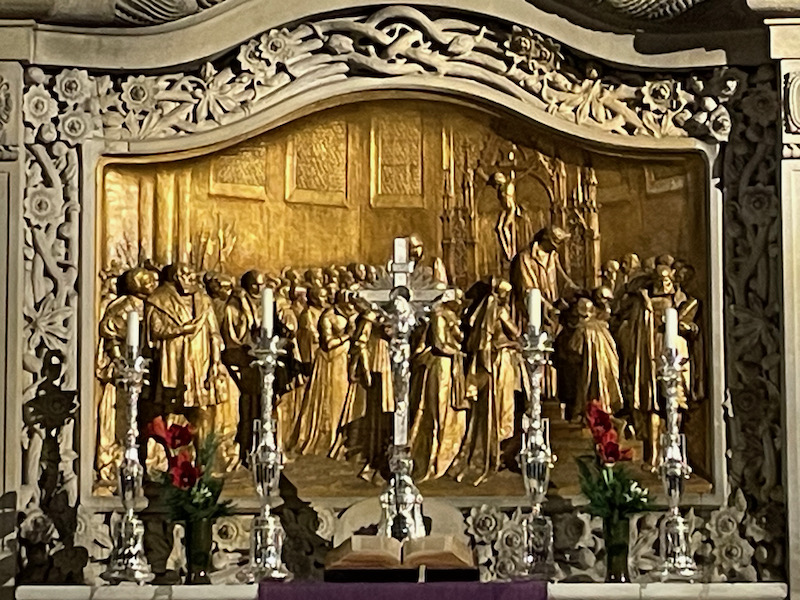
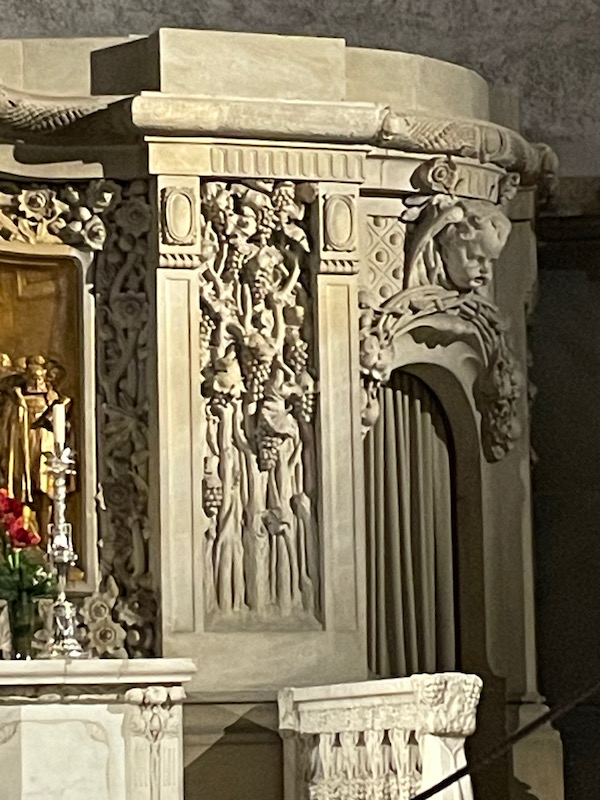
With dinner tonight, we went with a dark beer and a local cider ... this one Toffee Apple which was too sweet (I can't believe I am saying that!).
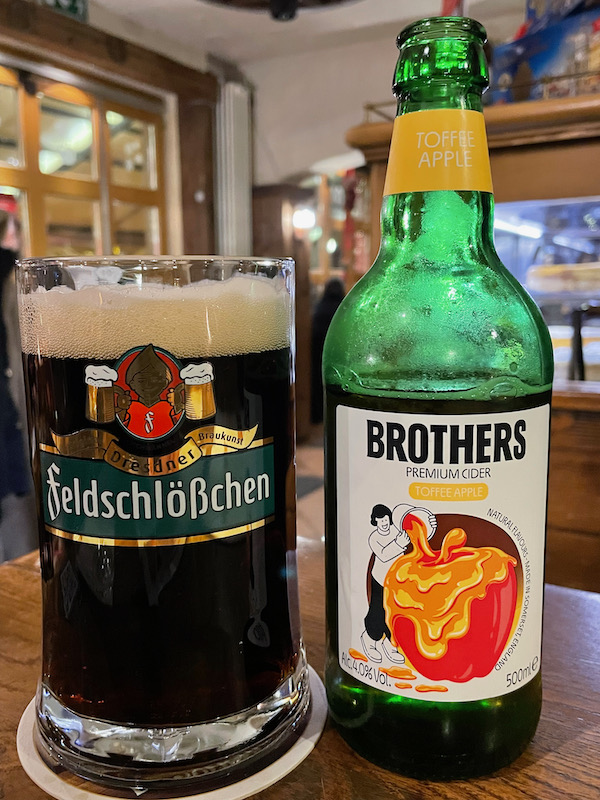
A few night pictures, the dome of the Academy of Fine Arts and the main Christmas market.
